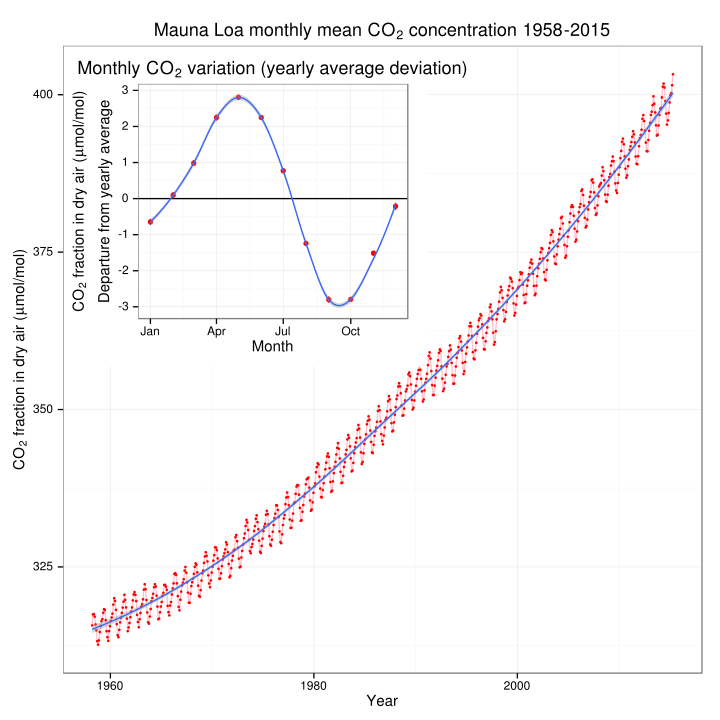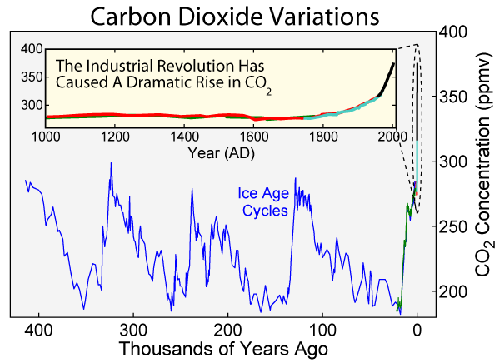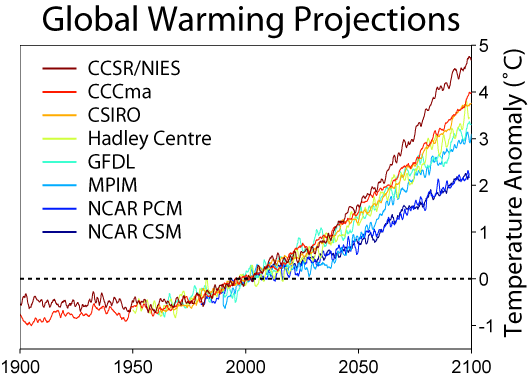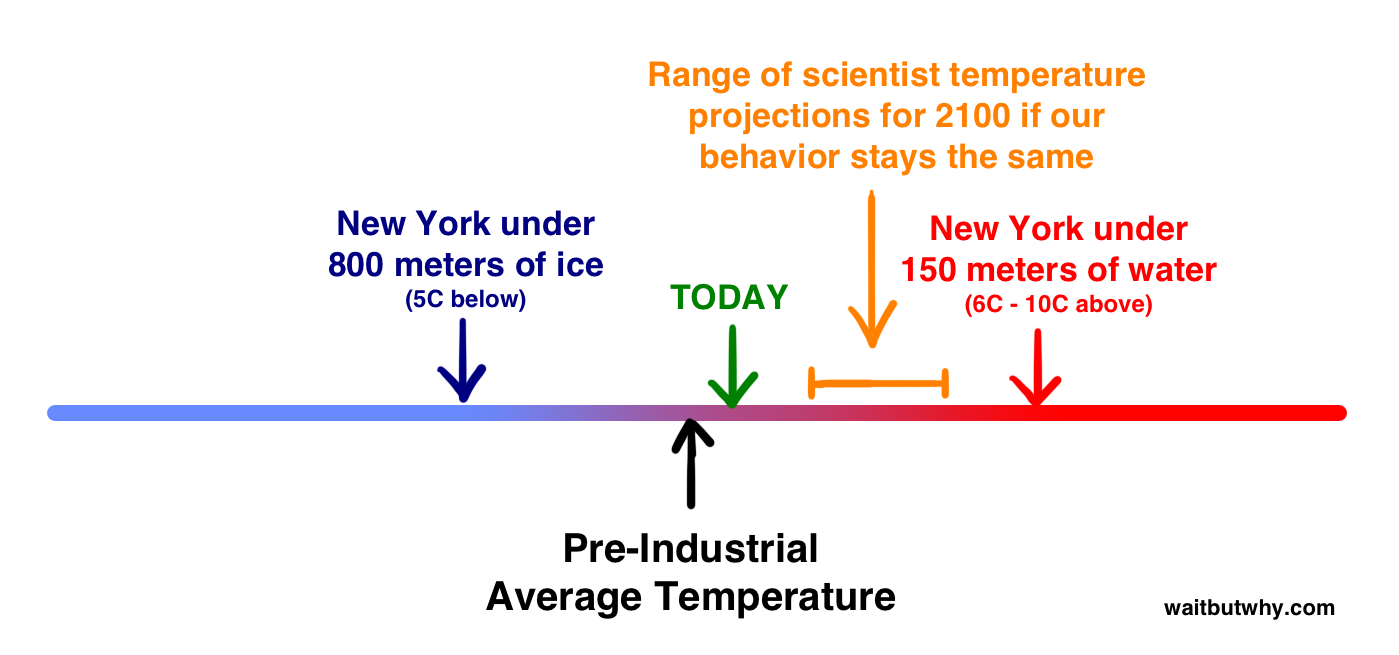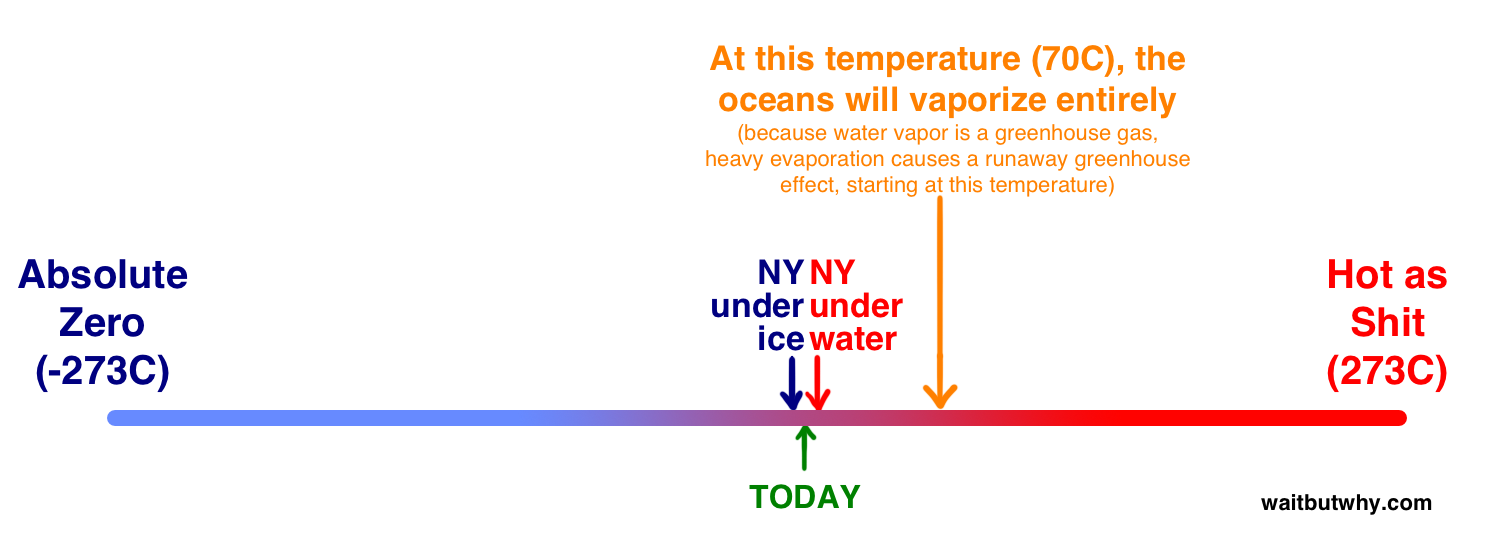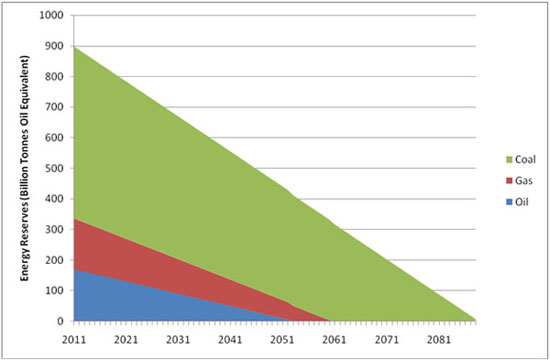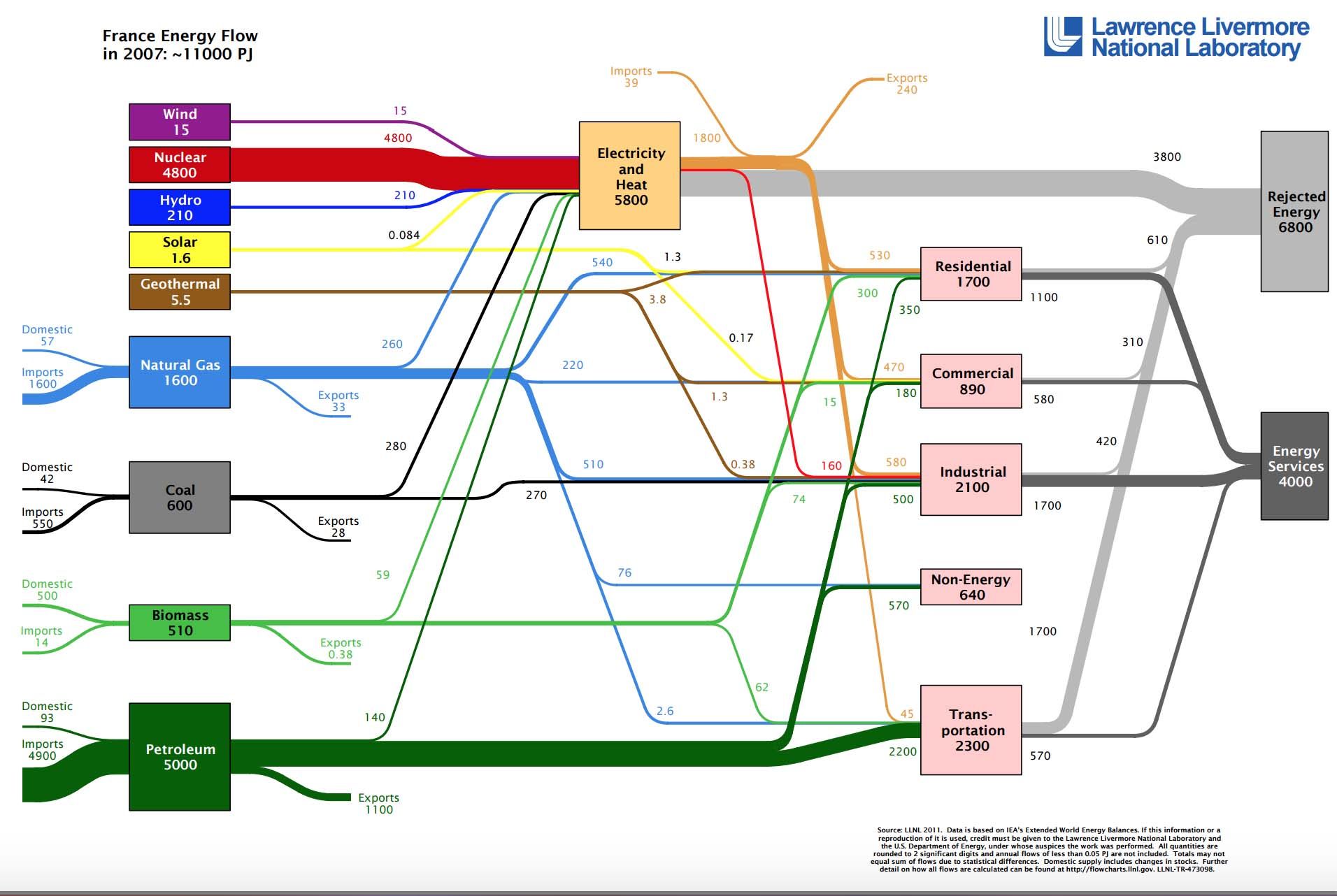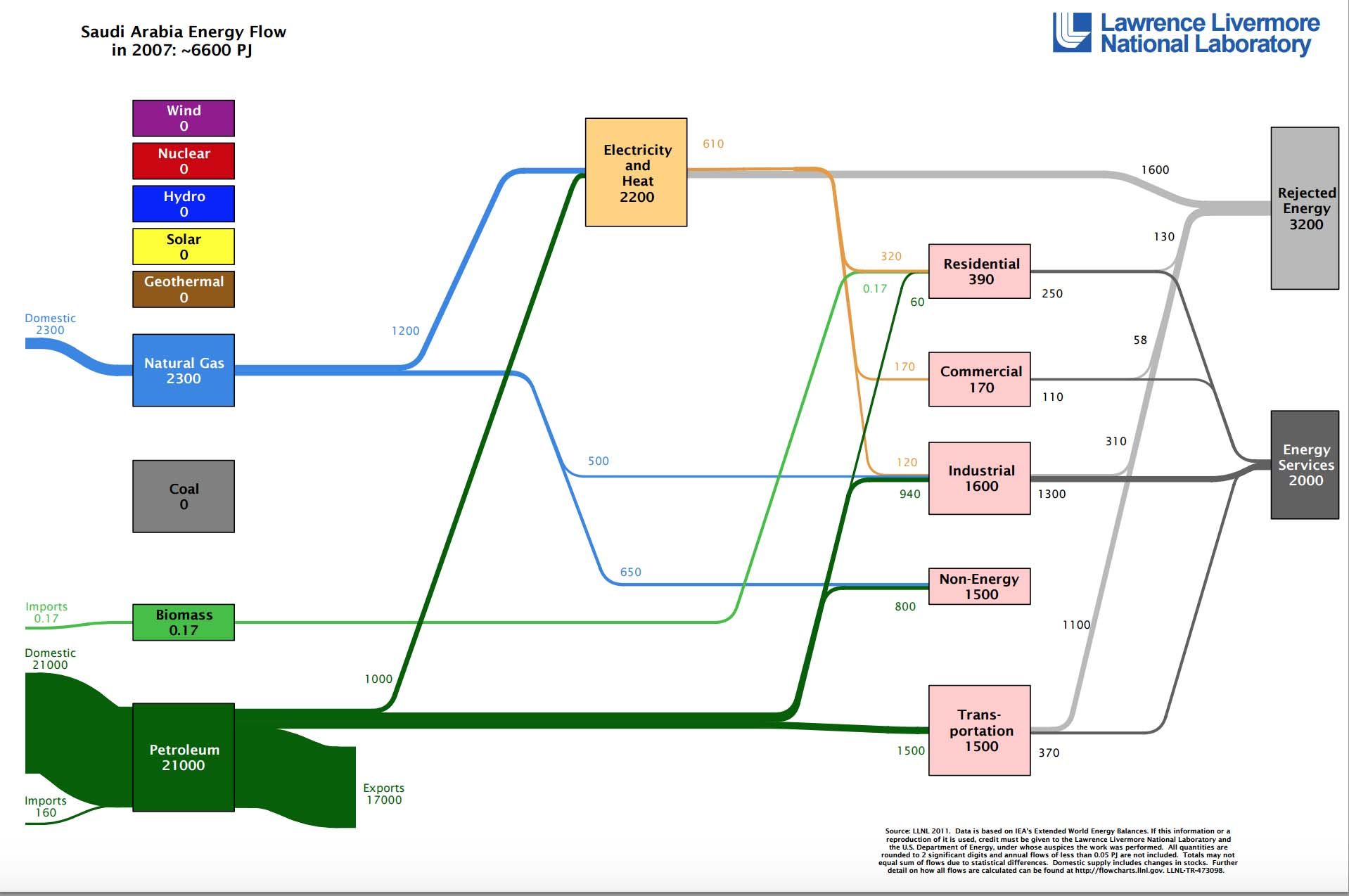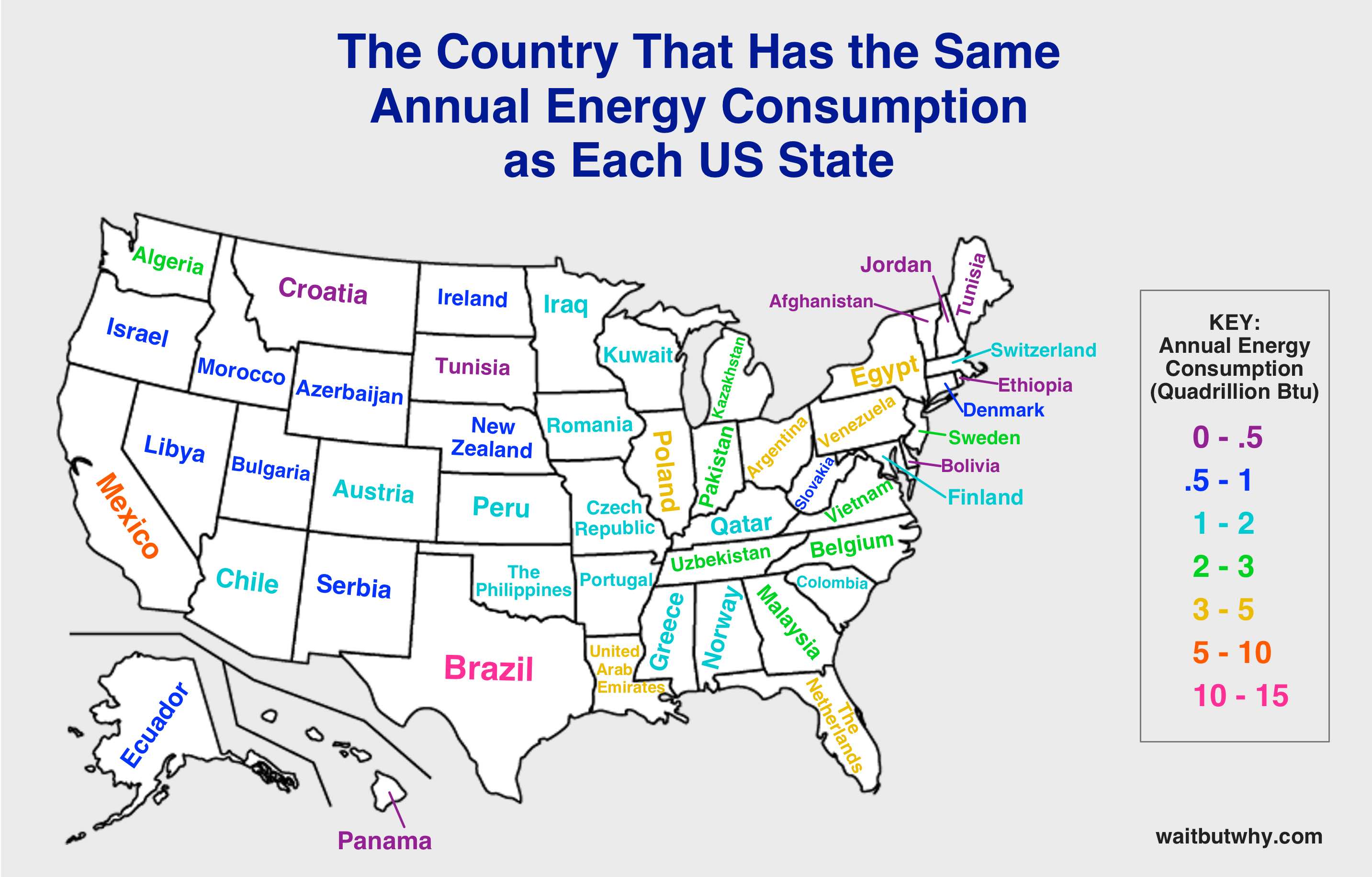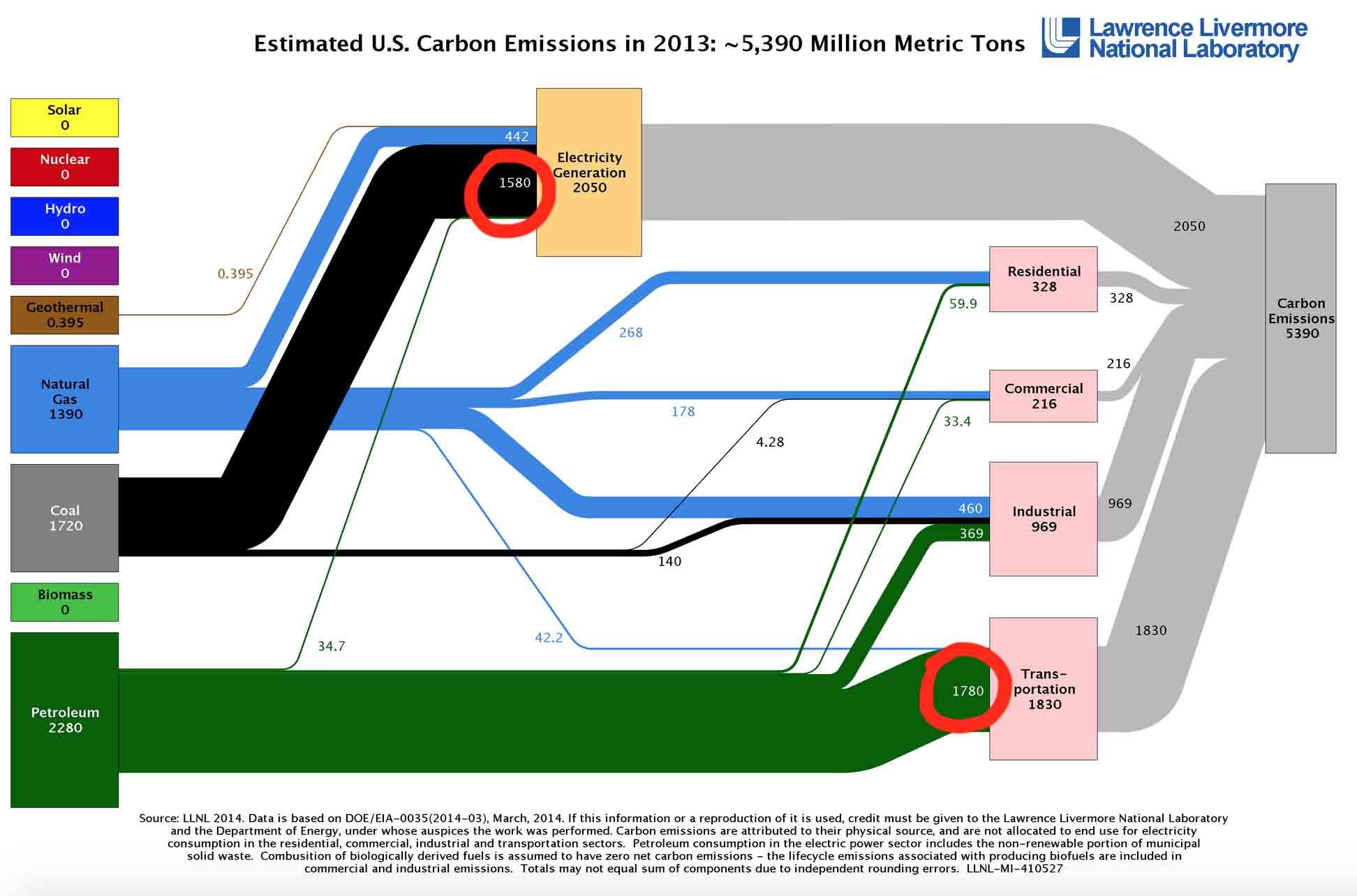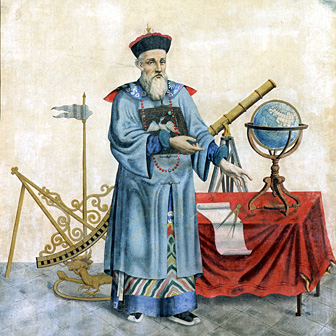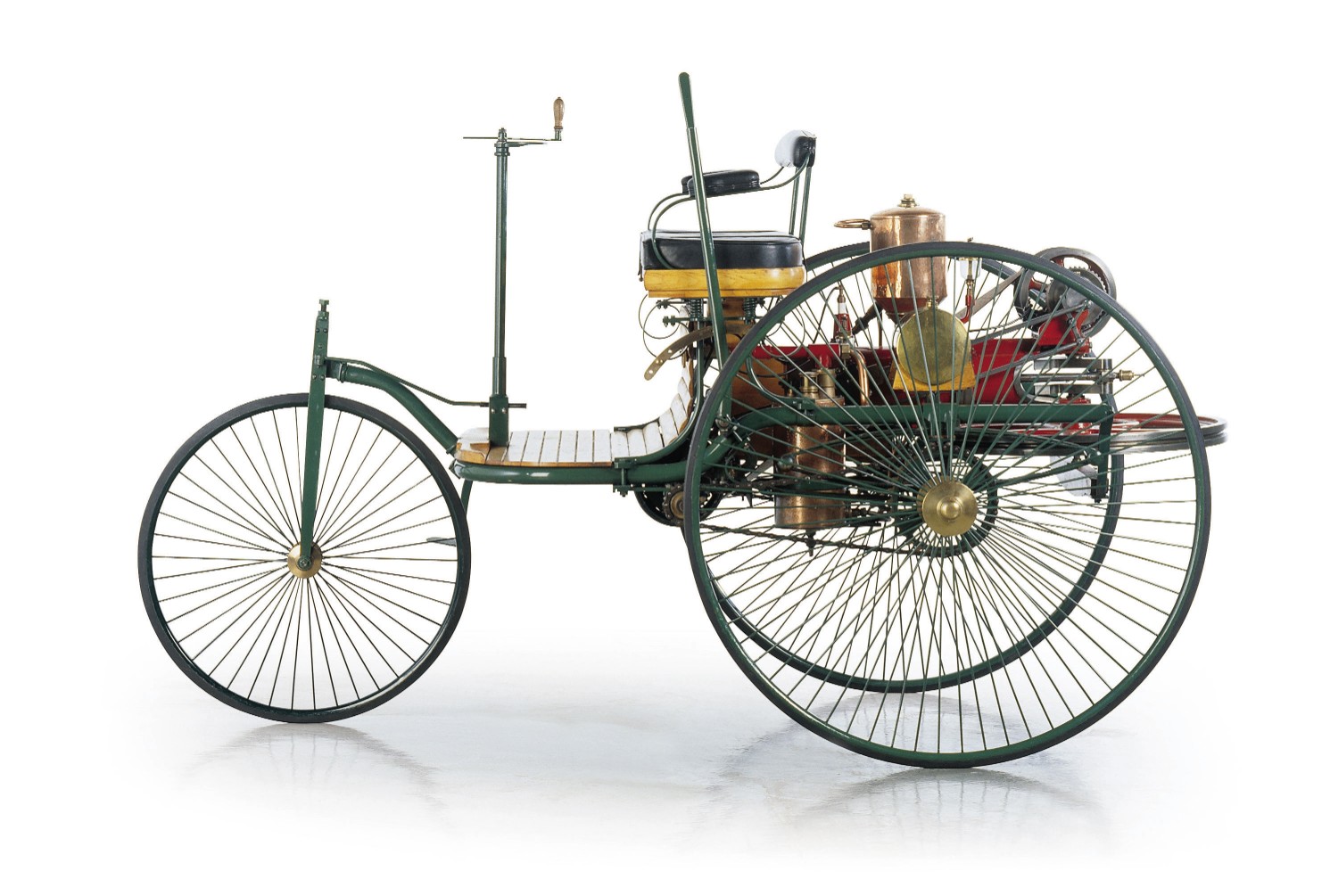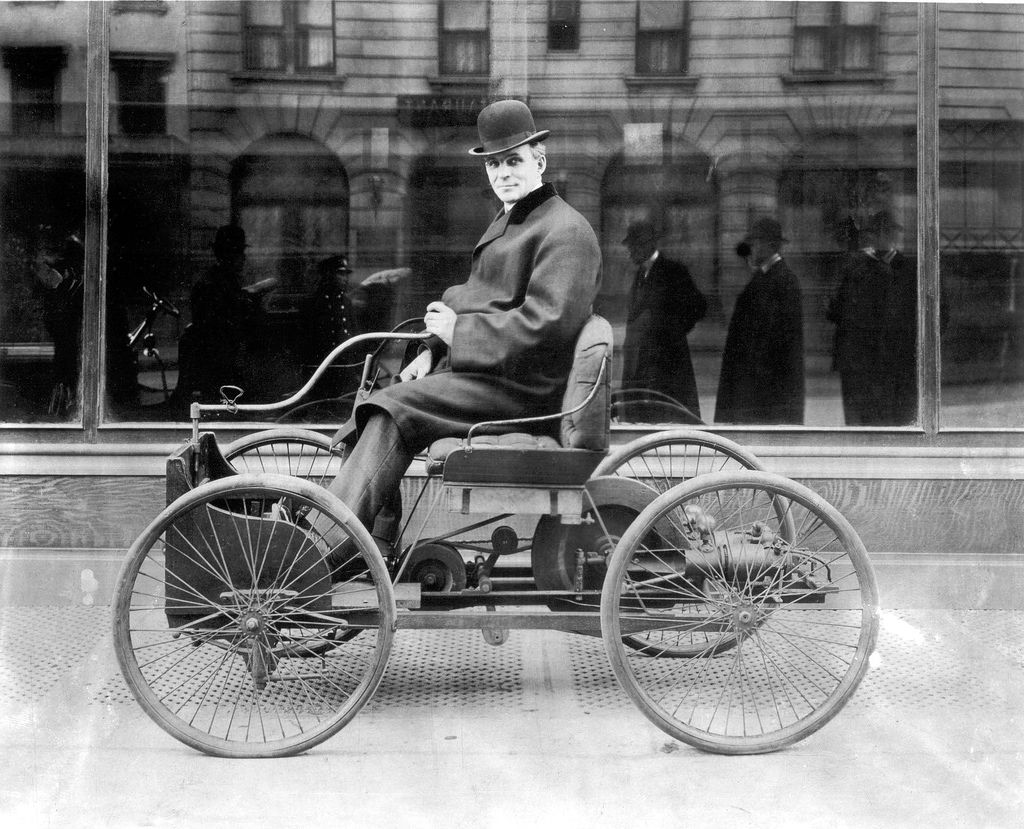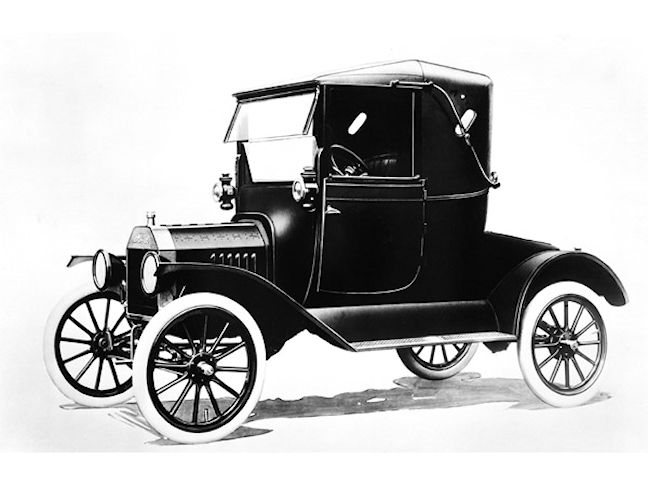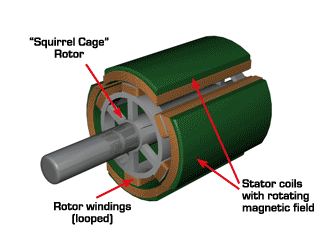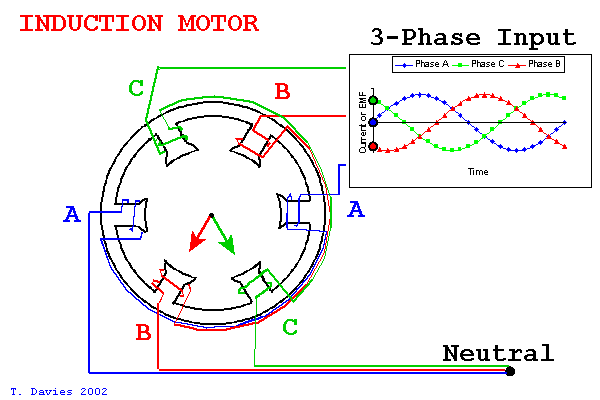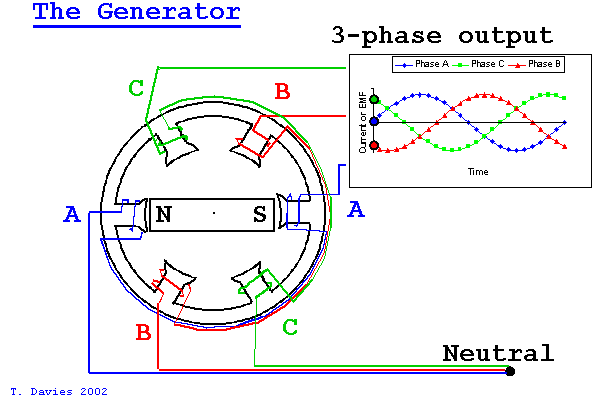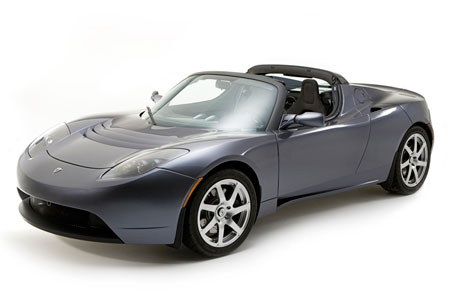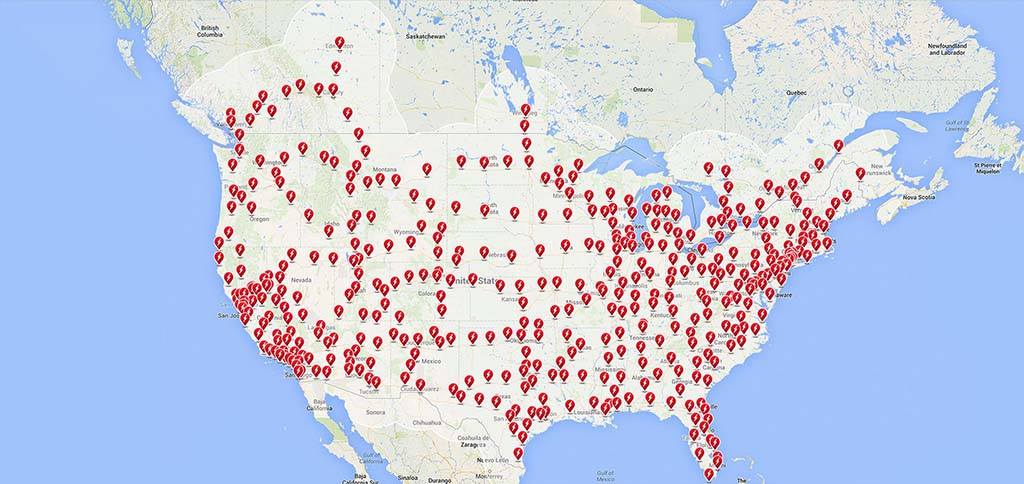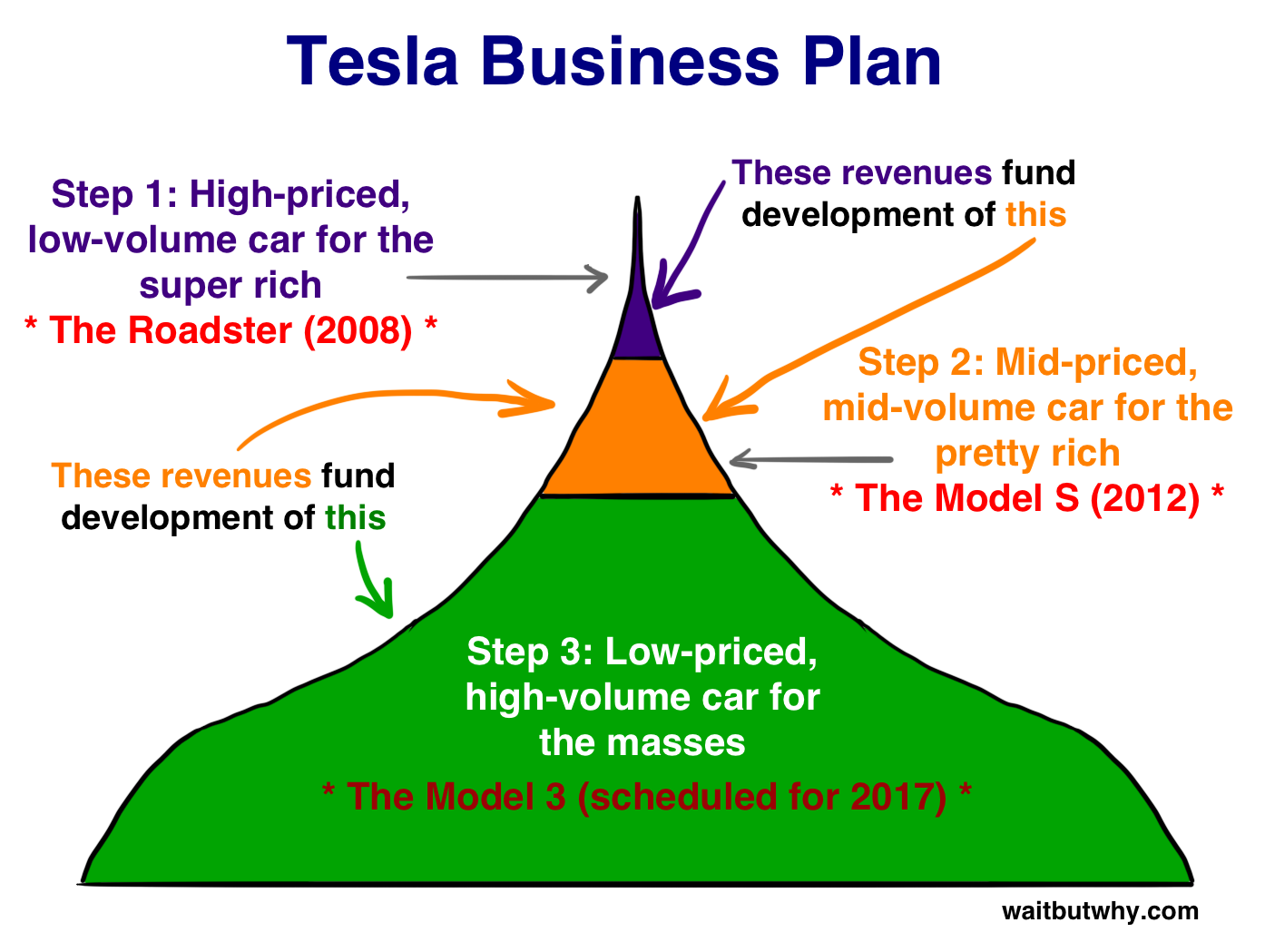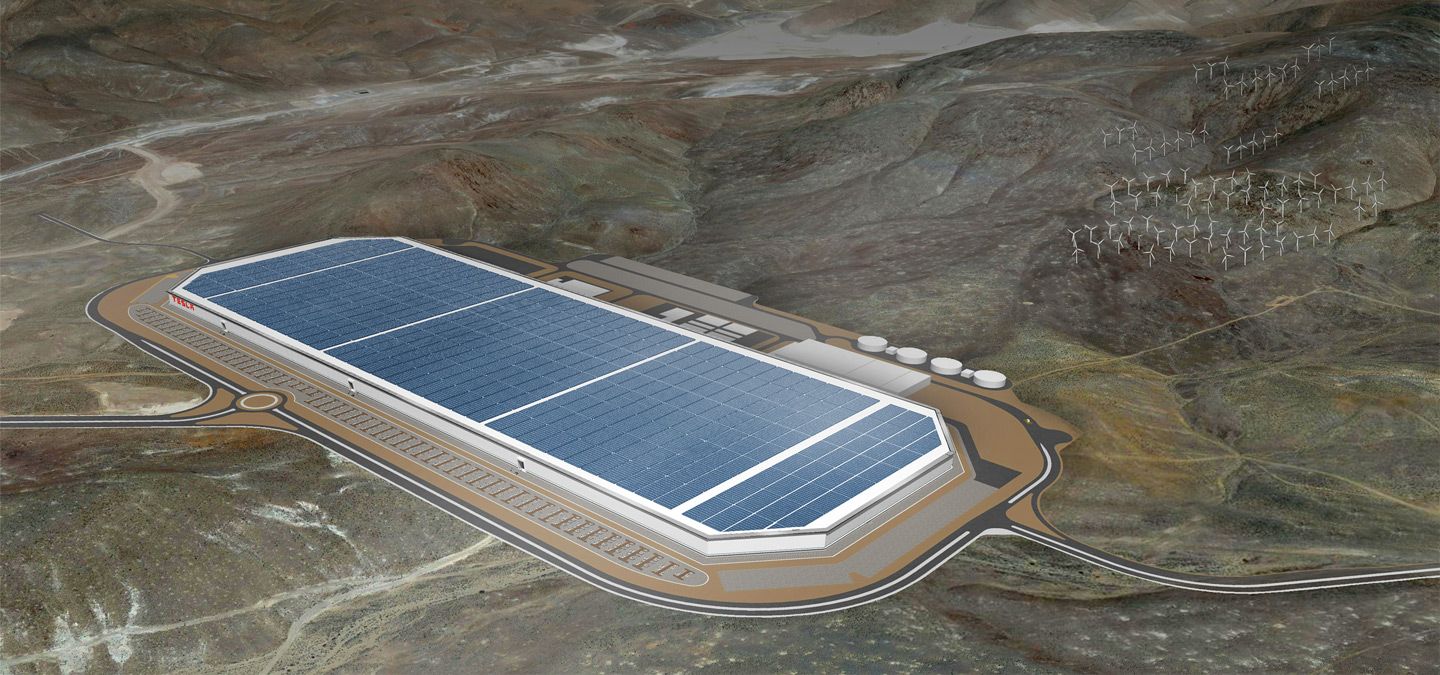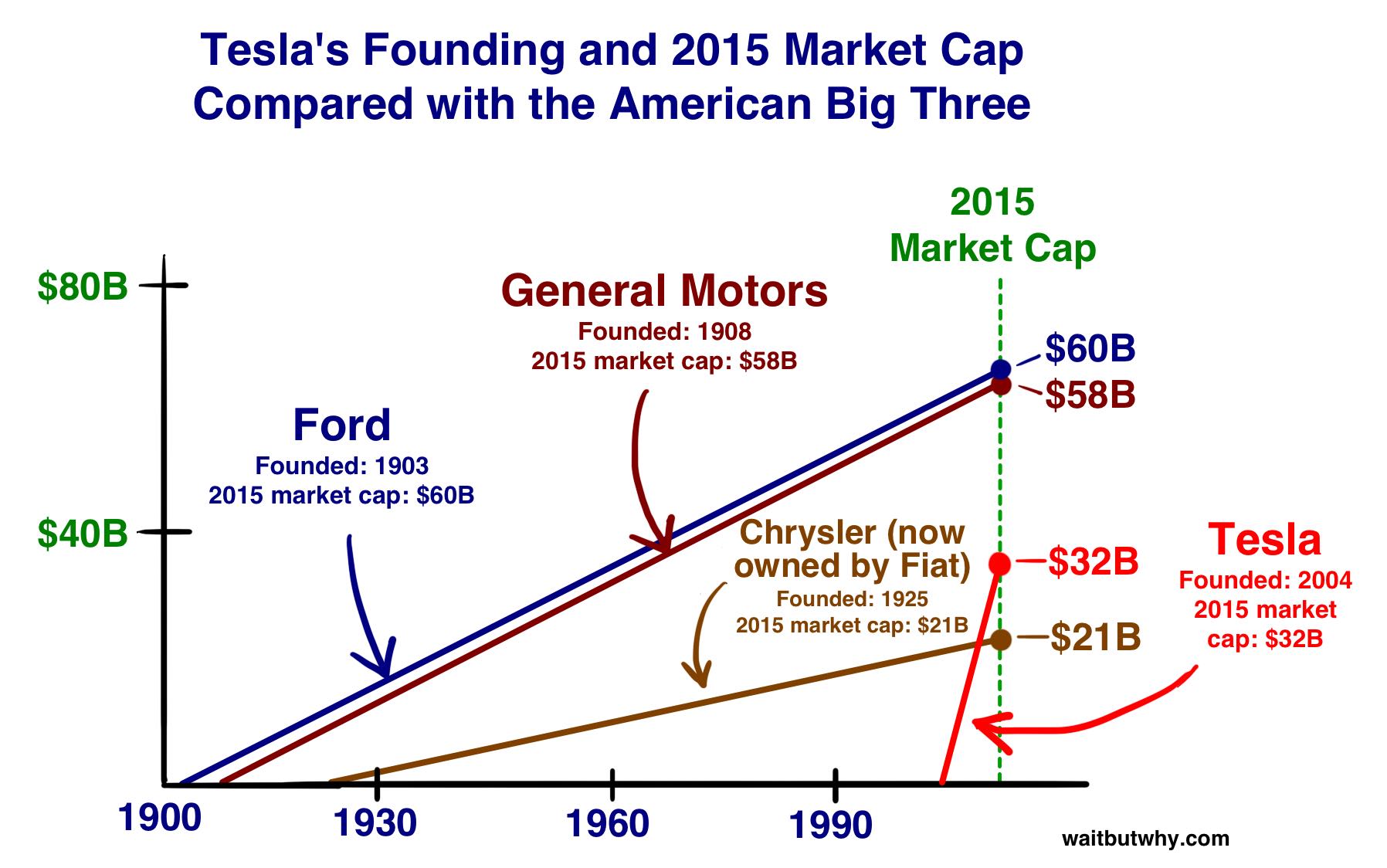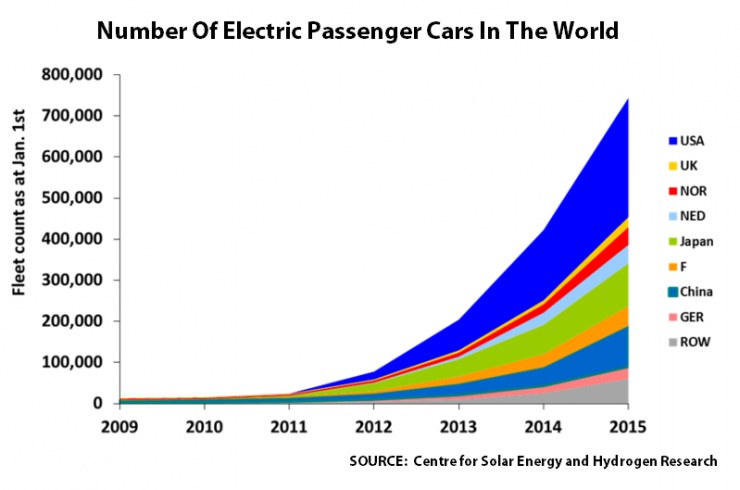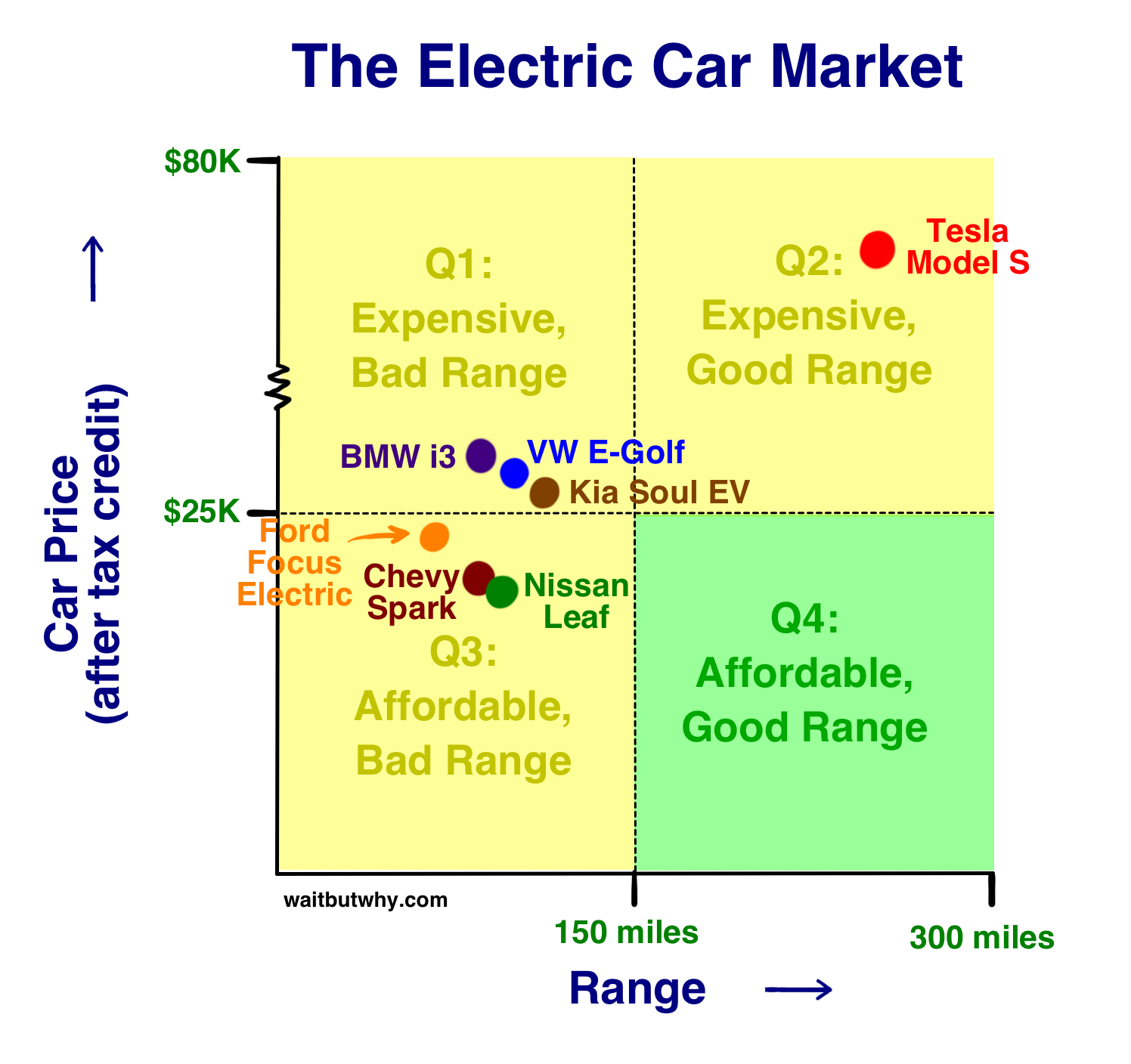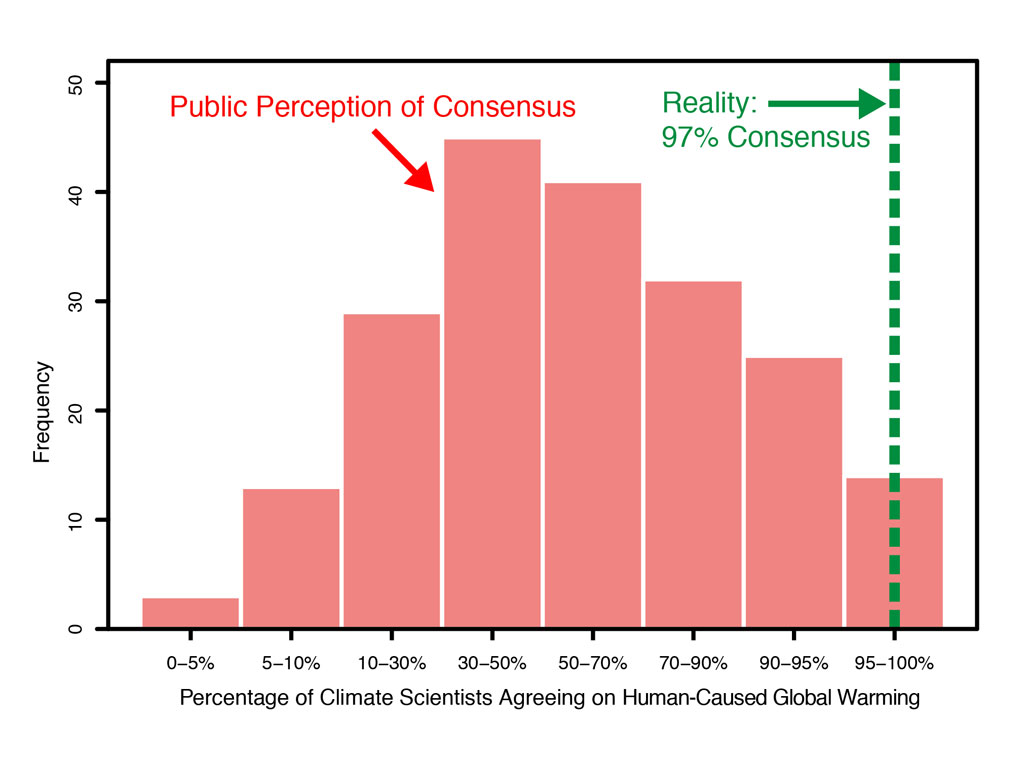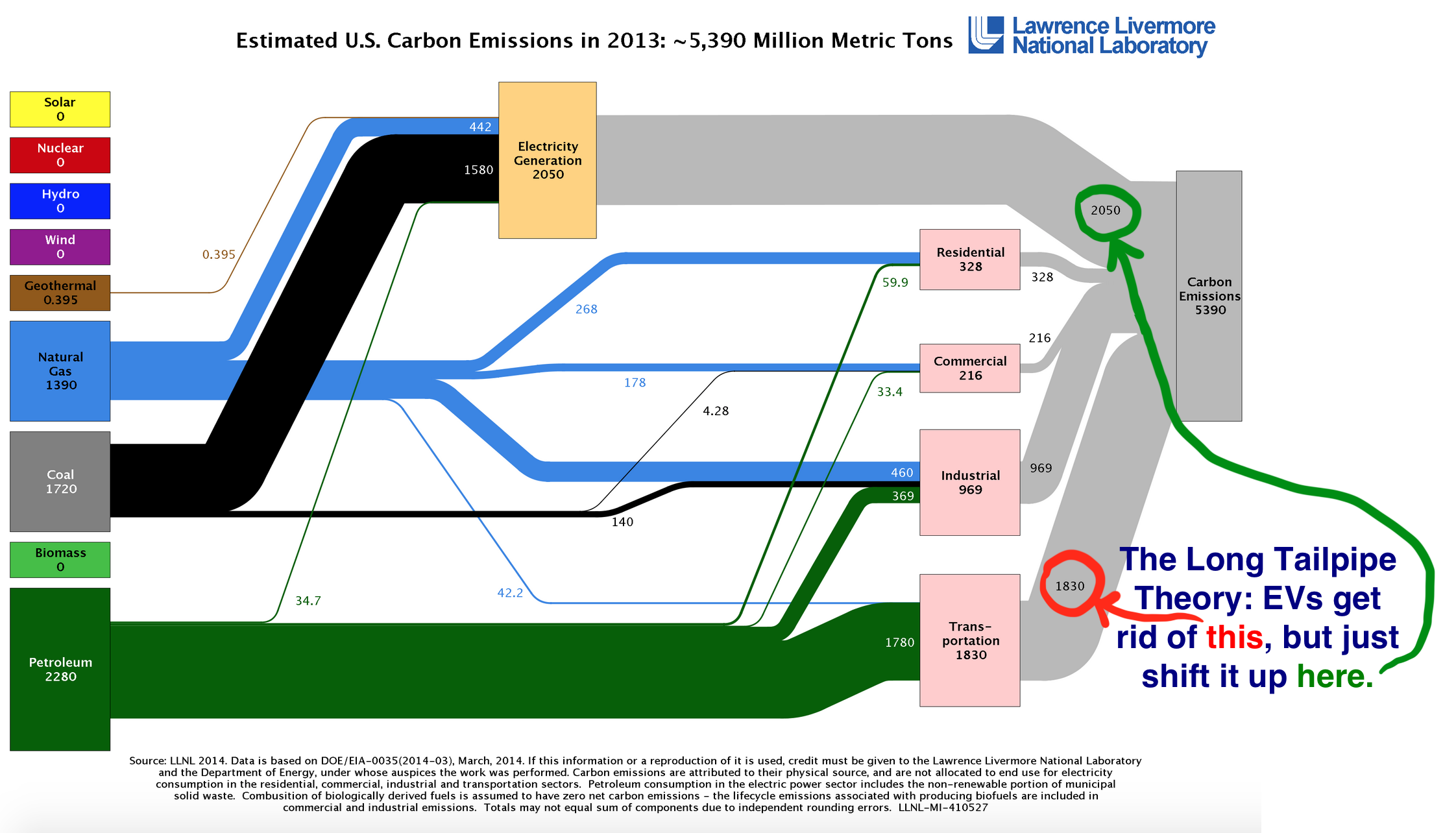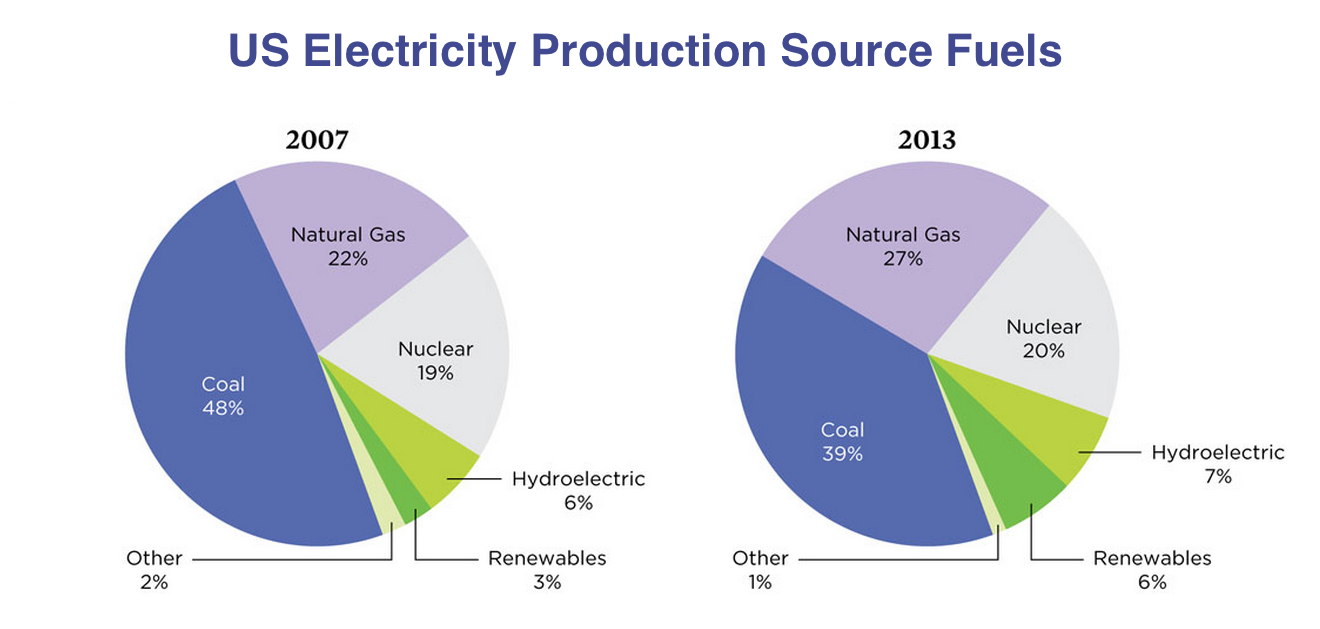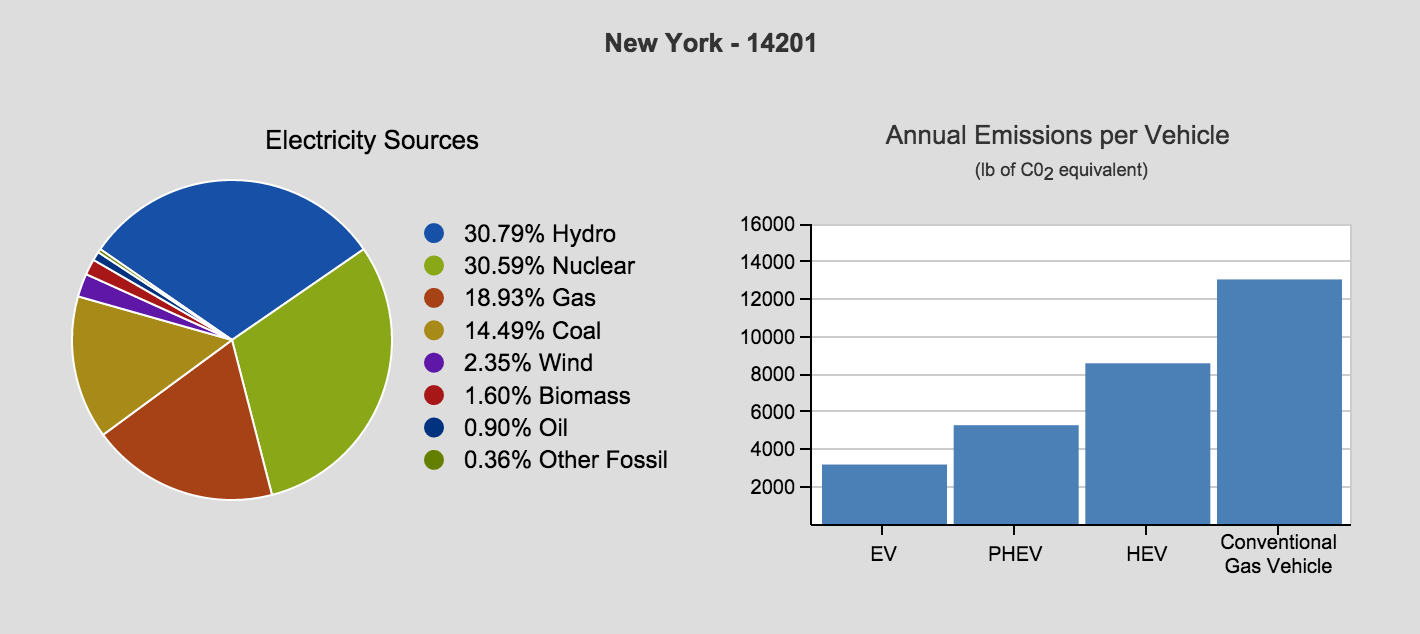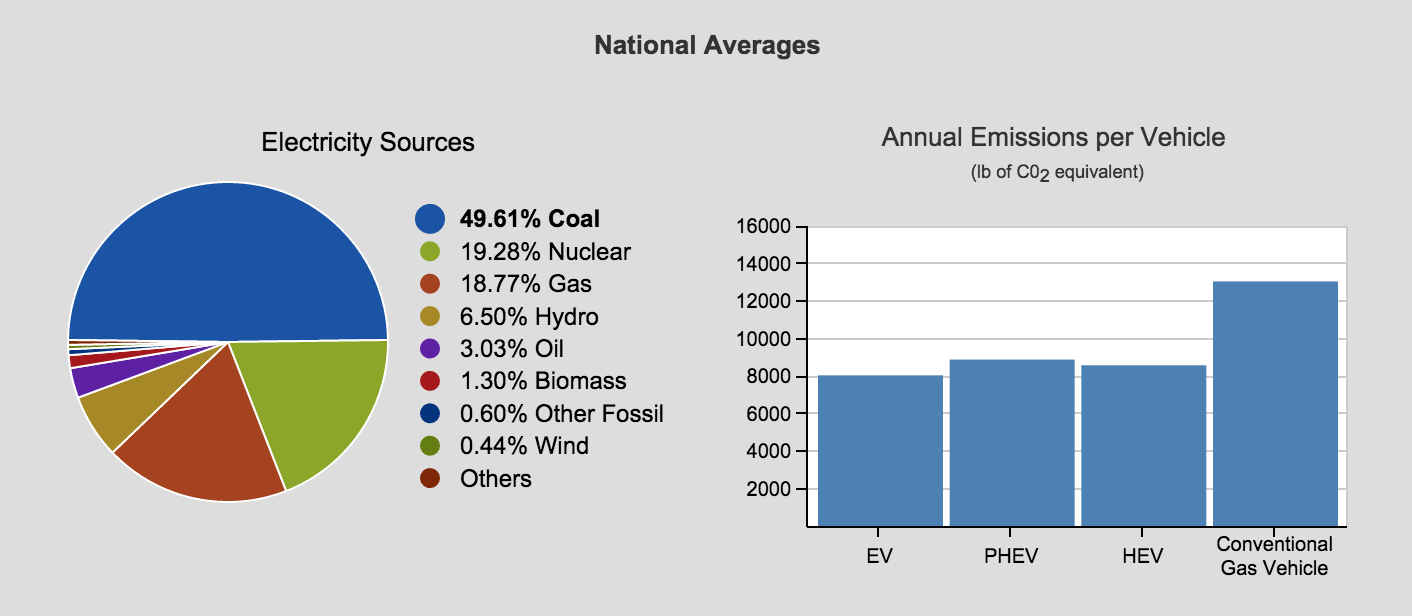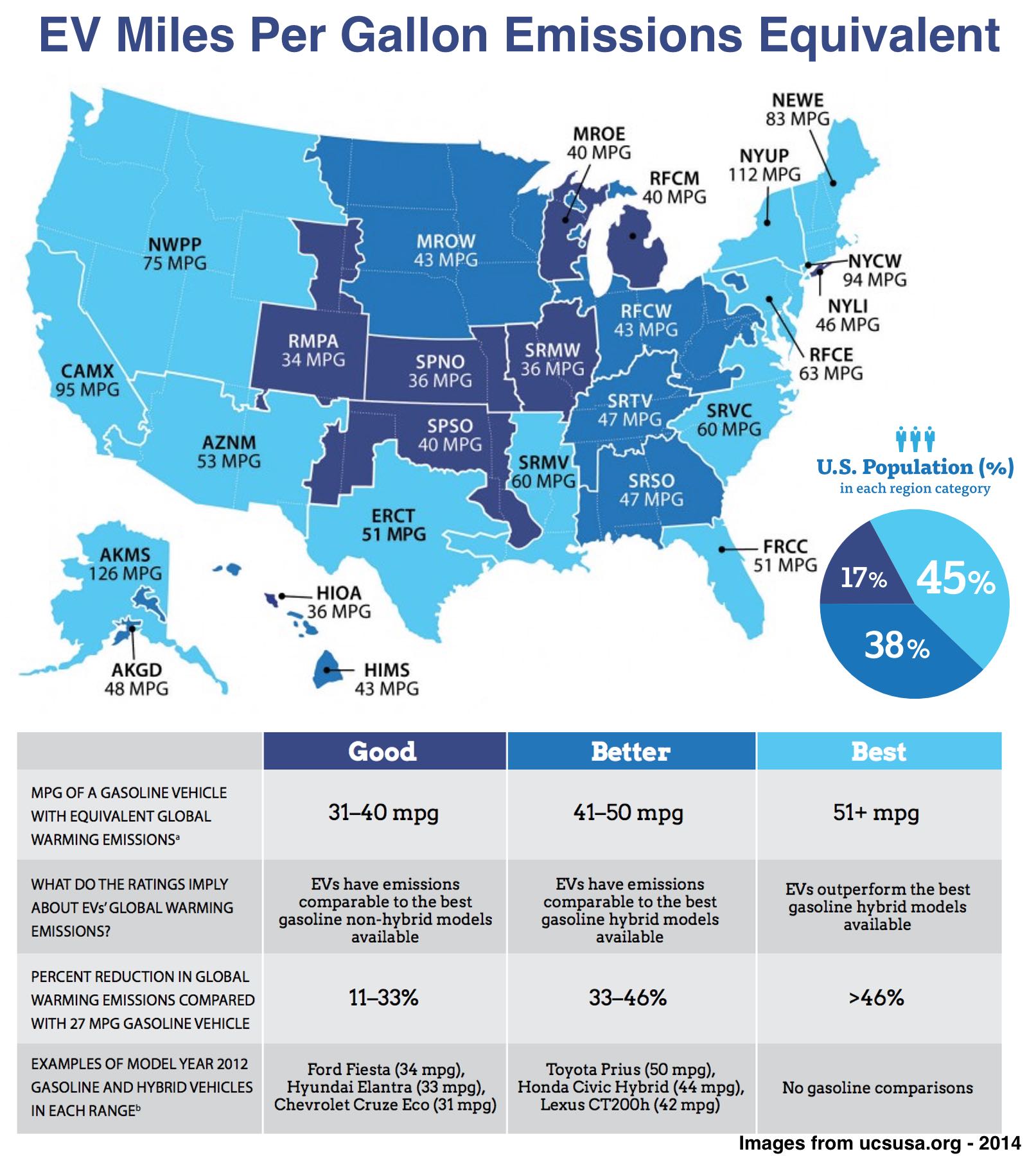This is Part 2 of a four-part series on Elon Musk’s companies. For an explanation of why this series is happening and how Musk is involved, start with Part 1.
____________
PDF and ebook options: We made a fancy PDF of this post for printing and offline viewing (see a preview here), and an ebook containing the whole four-part Elon Musk series:
___________
A Wait But Why post can be a few different things. One type of WBW post is the “let’s just take this whole topic and really actually get to the bottom of it so we can all completely get it from here forward.” The ideal topic for that kind of post is one that’s really important to our lives, and that tends to come up a lot, but that’s also hugely complex and confusing, often controversial with differing information coming out of different mouths, and that ends up leaving a lot of people feeling like they don’t totally get it as well as they “should.”
The way I approach a post like that is I’ll start with the surface of the topic and ask myself what I don’t fully get—I look for those foggy spots in the story where when someone mentions it or it comes up in an article I’m reading, my mind kind of glazes over with a combination of “ugh it’s that icky term again nah go away” and “ew the adults are saying that adult thing again and I’m seven so I don’t actually understand what they’re talking about.” Then I’ll get reading about those foggy spots—but as I clear away fog from the surface, I often find more fog underneath. So then I research that new fog, and again, often come across other fog even further down. My perfectionism kicks in and I end up refusing to stop going down the rabbit hole until I hit the floor.
For example, I kind of got the Iraq situation, but there was a lot of fog there too—so when I wrote a post about it, one fog-clearing rabbit hole took me all the way back to Muhammad in 570AD. That was the floor. Digging into another part of the story brought me to the end of World War I. Another brought me to the founding of ISIS.
Hitting the floor is a great feeling and makes me realize that the adults weren’t actually saying anything that complicated or icky after all. And when I come across that topic again, it’s fun now, because I get it and I can nod with a serious face on and be like, “Yes, interest rates are problematic” like a real person.
I’ve heard people compare knowledge of a topic to a tree. If you don’t fully get it, it’s like a tree in your head with no trunk—and without a trunk, when you learn something new about the topic—a new branch or leaf of the tree—there’s nothing for it to hang onto, so it just falls away. By clearing out fog all the way to the bottom, I build a tree trunk in my head, and from then on, all new information can hold on, which makes that topic forever more interesting and productive to learn about. And what I usually find is that so many of the topics I’ve pegged as “boring” in my head are actually just foggy to me—like watching episode 17 of a great show, which would be boring if you didn’t have the tree trunk of the back story and characters in place.
So when it was time to start what I had labeled in my head as “the Tesla post,” I knew this was going to be one of those posts. To understand if and why Tesla Motors matters, you have to understand both the story of cars and the story of energy—two worlds I somehow am simultaneously confused by and tremendously sick of. Just hearing someone say “climate change” or “energy crisis” or “tailpipe emissions” makes me kind of gag at this point—just too much politics, too many annoying people, too much misinformation on all sides, and it’s just hard to know how much I actually care and if there can be a solution to all of it anyway. So I did what I do when my tortoise shits when I’m out of the apartment and then spends hours walking through it and tracking it across everything, including the walls somehow—I rolled up my sleeves, took a deep breath, whispered, “Be a man, Tim,” and started scraping through layers of shit. If I have to live in a world with people arguing constantly about energy and oil and greenhouse gases and incentive programs, I might as well build myself a proper tree trunk.
After weeks of reading and asking questions and writing, I’ve emerged from the tortoise sewage with something that toes the line between a long blog post and a short book. I could have broken this into multiple posts, but it’s all one story and I wanted to keep it all together. It’ll be a bit of a time investment, but I think you’ll come out of it with a sturdier tree trunk about all of this than you have now. And as it turns out, when it comes to this topic, we may be witnessing a very awesome moment in history without quite realizing it yet.
Two disclaimers before we start:
1) This is a highly politicized issue, but this post has no political agenda. I’m not political because nothing could ever possibly be more annoying than American politics. I think both parties have good points, both also have a bunch of dumb people saying dumb things, and I want nothing to do with it. So I approached this post—like I try to with every post—from a standpoint of rationality and what I think makes sense.
2) Spoiler: The post is very pro-Tesla. Which might seem suspicious since A) Elon Musk asked me to write about this and B) I just wrote a post calling him the raddest possible man. But two things to keep in mind:
First, this isn’t commissioned by Musk, and I’m being paid $0.00 for doing it. He suggested I take the issue on because I think he thinks there’s a lack of full tree trunks in people’s heads about it—but he never suggested that I say good things about Tesla, electric cars, or anything else.
Second, the currency Wait But Why lives on is integrity. Without it, WBW loses its ability to make an impact. And integrity came first here, even at the expense of Musk potentially hating me at the end of it, if that’s what was necessary. If I didn’t think this would have made a great WBW topic, I wouldn’t have taken it on, and I’m pro-Tesla in the post because after a ton of learning and thinking—including as many counterarguments to Tesla and its worldview as I could find—that’s how I feel.
And with that, let’s dive in.
Contents
Part 1: The Story of Energy
Part 2: The Story of Cars
Part 3: The Story of Tesla
___________
Energy is important. Without energy, we’d all be like this:
But what really is energy? The dictionary says it’s “the property of matter and radiation that is manifest as a capacity to perform work.” And it says “work” is “the exertion of force overcoming resistance or producing molecular change.” Putting that together, we get energy being “the property of matter and radiation that is manifest as a capacity to perform the exertion of force overcoming resistance or producing molecular change.”
That was pretty unfun, so for our purposes, let’s call energy “the thing that lets something do stuff.”
But the tricky thing about energy is the law of conservation of energy, which says that energy can’t be created or destroyed, only transferred or transformed from one form to another. And since every living thing needs energy in order to do stuff—and you can’t make your own energy—we’re all awkwardly left with no choice but to steal the energy we need from someone else.11← click these
Almost all of the energy used by the Earth’s living things got to us in the first place from the sun.2 The sun’s energy is what makes the wind blow and the rain fall and it’s what powers the Earth’s living things—the biosphere.
The joule is a common unit of energy—defined as the amount of energy it takes to apply a force of one newton through a distance of one meter3. While the sun’s joules can provide any animal with heat and light, the joules that power all of us from the inside enter the biosphere in the first place when the sun gives them to plants.
That’s how food is invented—plants know how to take the sun’s joules and turn them into food.
At that point, all hell breaks loose as everyone starts murdering everyone else so they can steal their joules.
We use “the food chain” as a cute euphemism for this murder/theft cycle, and we use the word “eating” to refer to “stealing someone else’s joules and also murdering them too.” A “predator” is a dick who always seems to want your joules over everyone else’s, and “prey” is just some sniveling nerd you particularly like to bully and steal lunch money from. Plants are the only innocent ones who actually follow the Golden Rule, but that’s just because they have the privilege of having the sun as their sugar daddy—and humans are the biosphere’s upsetting mafia boss who just takes what he wants from anyone he wants, whenever he wants. It’s not a great system, but it works.
And that all went on normally for a while, but in the last few hundred thousand years, humans started to realize something: while it was enjoyable to put new joules into your body, actually using those joules sucked. It’s much less fun to use a bunch of joules running fast or lifting something heavy than it is to just sit on a log pleasantly and hold onto those joules instead. So humans got clever and started to figure out ways to get joules outside their bodies to do work for them—by doing that, humans could have their joules and eat them too. Sometimes the methods would be dickish:
But joules aren’t only in living things. There are joules floating and swirling and zooming all around us, and by inventing the concept of technology, humans figured out ways to get use out of them. They made windmills that could steal some of the wind’s joules as it went by and convert them into mechanical energy to grind food. They built sailboats that would convert wind joules into kinetic boat energy they could control. Water absorbs the sun’s radiation joules and turns them into gravitational potential energy joules when it evaporates and then kinetic energy joules when it rains and slides down land, and humans saw the opportunity to snatch some of those up by creating water wheels or dams.
But the most exciting joule-stealing technology humans came up with was figuring out how to burn something. With wind or water, you can only capture moving joules as they go by—but when you burn something, you can take an object that has been soaking up joules for years and release them all at once. A joule explosion.
They called this explosion fire, and because the joules that emerged were in the useful-to-humans formats of heat energy and light energy, burning things became a popular activity.
Taming a Dragon
We had learned to harness the joules of the wind and the water—to take those forces by the reins and make them ours—but when it came to the most joule-heavy force of all, fire, we couldn’t really figure out how to do anything with it other than hang out near it, cook some stuff, and generally benefit from its existence. Fire was a hectic dragon and no one had figured out how to grab its reins.
And then came the breakthrough. Steam.
Fire joules were hard to harness, but if you sent them into water, they’d get the water molecules to increasingly freak out and bounce around until finally those molecules would fully panic and start flying off the surface, evaporating upwards with the force of the raging fire below. You’d have successfully converted the thermal energy joules of the fire—which we didn’t know how to directly harness—into a powerful jet of steam we could control.
With the muscle of steam in their toolkit, the inventors of the 18th century burst into innovation. They had some serious joules to work with now, which opened worlds of previously-unthinkable possibility. Breakthroughs led to more breakthroughs, and at the turn of the 19th century, the progress culminated in an invention that’s often called the most impactful turning point in human history: the steam engine.
Picture your tea kettle when it gets all angry at you and starts whistling. Now imagine that instead of the steam spewing out through the nozzle, you connected the nozzle to a tube, which directs the bursting steam into an empty cylinder and then finally releases it. When the steam goes into and then out of the cylinder, it shoves a “piston” inside the cylinder on a powerful back-and-forth motion. That’s (a dramatic oversimplification of) how a steam engine works. Depending on the vehicle, the back-and-forth motion of the piston can do different things. In the example of a locomotive, the piston is attached to a rod whose back-and-forth motion turns the wheels:2
Using the steam engine, humanity upgraded from sailboats to steamships and from animal-drawn carts to locomotives.4 Inside factories, people put steam to work too, swapping out their water wheels for much more effective steam-powered wheels.
With the new ability to transport many more goods and materials, much farther away, much more quickly, and to far more efficient factories, the Industrial Revolution ignited in full force. People say the Industrial Revolution was powered by steam, but steam was just the middleman—after hundreds of thousands of years of existing as passive benefactors of combustion, we had tamed the dragon, and the Industrial Revolution was powered by fire.
Striking Gold
The one thing about having made fire our bitch is that we now wanted to burn a lot more things than we ever had before. For most of human history, when people wanted to burn something, they just went and found some wood. Easy. Except now it was the 19th century, and with our new appetite to burn, wood wouldn’t cut it anymore.
We knew there were other things we could burn—in Britain, they would often supplement wood by burning a black rocky substance they found on their shores. They called it coal.
The problem is that unlike wood, most of the coal in Britain wasn’t just sitting conveniently on land—it was underground. When the Industrial Revolution got going, the British started digging—they were gonna need a lot of coal. As the revolution spread through Europe and to North America, Europeans and Americans started digging too—they also were gonna need a lot of coal.
As everyone dug, they started finding other things too. They found pockets of burnable air we call natural gas and underground lakes of thick, black burnable liquid we call crude oil. It turns out that this whole time, humans had been walking around with a vast untapped treasure of tightly packed, burnable joules right underneath them. It was like a dog digging in the woods to bury a bone and uncovering an underground cave full of pulled pork.
And what does a dog do who finds a cave of pulled pork? Does he pause to think cautiously about how to proceed or consider consequences for his health? No—he eats the shit out of it. Mindlessly, at full speed.
And throughout the 19th century, coal mines and oil rigs popped up everywhere. Burning this new treasure of joules made economies soar and the incentive to innovate soared along with them—and new, fantastic technologies were born.
Like steam engine technology, the credit for the electricity revolution is owed to a collaboration of dozens of innovators spanning centuries, but it was in the 1880s that it all finally came together. In what is still probably the most significant technological shift of all time, electricity allowed the raucous power of burning to be converted into a highly tame and remarkably versatile form of energy called electrical energy. With steam as a key middleman, all those spastic combustion joules could now be sent into an organized grid of wires, transferred long distances, and delivered into residential and commercial buildings where it would wait patiently in an outlet ready to be discharged at the user’s convenience.5 At that point, the now electrical joules could be converted into almost any kind of energy—they could boil water, freeze ice, light up the room, or make a phone call. If steam had tamed the dragon, electricity had turned the dragon into a magical butler, forever at our service. And for the first time in human history, the power was on.
Right around the time this was happening, another revolution was underway. Fire was now powering our ships, our trains, our factories, and even the new wizardry of electricity, but individual transportation was still powered by hay like it was 1775—and late 19th century humanity knew we could do better. Biological horses got super upset if you tried to power them by fire, so again, humanity got innovating, and a couple decades later, there were big, metal horses everywhere with engine cylinders full of fire.
As coal, oil, and natural gas motivated unprecedented innovation, the resulting waves of new technologies created an unprecedented need to burn stuff—which motivated the diggers. Companies that focused on digging, sucking, and siphoning up more and more of our underground joule treasure, like John D. Rockefeller’s Standard Oil, became the world’s biggest corporate empires. It was a new world, powered by an endless cave of pulled pork, being gorged upon by the world’s happiest dog…
___________
Flash forward to the present day.
Burning our bounty of underground joule-packed fuel to power our world is now an innovation more than two centuries old—but in 2015, it’s still the main way humans get their power:3
That’s the thing about dogs—if given something delicious, they tend to eat until the food runs out or they get sick, whichever comes first, and there aren’t too many other factors in play. The modern energy debate essentially boils down to whether it’s okay that the dog is still fully enjoying himself in the cave or whether it’s not because he might be making himself dangerously sick or risk running out of pulled pork—which would be a problem, because he has grown increasingly large since finding the cave, and he has no way outside the cave of feeding his now-immense appetite.
As you might have noticed, there are a lot of people who have a lot of opinions for a lot of reasons saying a lot of things about this situation. And some are saying real things, but a large portion of them either don’t especially know what they’re talking about or they have some ulterior motive for saying what they’re saying. This makes an already complex, murky, multi-faceted topic even more confusing.
So let’s lay out what we do know and try to clarify what the hell is really going on.
To begin with—what exactly are fossil fuels and where do they come from?
Fossil fuels are called fossil fuels because they’re the remains of ancient living things. “Ancient” in this case spans a wide range. The earliest organisms that contribute to today’s fossil fuels lived during the Precambrian Eon, before there were any plants and animals on land—the fossil organisms then would have been ocean algae. People often think fossil fuels are made of dinosaurs, but any dinosaurs in our gasoline are from the last couple hundred million years—the later stretch of the timespan—and only a small contributor. The largest portion of our fossil fuels comes from plants, animals, and algae that lived during the Carboniferous Period—a 50 million year period that ended about 300 million years ago and during which there were lots of huge, shallow swamps. The swamps were important because it made it more likely that a dead organism would be preserved. You don’t become a fossil fuel if you die in a normal place and decompose away. But by dying in a swamp and sinking to the bottom, Carboniferous organisms often ended up being quickly covered by sand and clay and were able to make it underground with their joules still intact.
After hundreds of millions of years, all those organisms were squashed under intense heat and pressure and became converted into joule-dense solid, liquid, or gas—coal, oil, and natural gas. Quick blue box brush-up:
Fossil Fuels Brush-Up
Coal, a black sedimentary rock that’s found in underground layers called coal beds, is the cheapest and most plentiful of the three and is used almost entirely for making electricity. It’s also the worst culprit for CO2 emissions, releasing about 30% more CO2 than the burning of oil and about double that of natural gas when generating an equivalent amount of heat.4 The US is to coal as Saudi Arabia is to oil, possessing 22% of the world’s coal, the most of any nation. China, though, has become by far the world’s largest consumer of coal—over half of the coal burned in the world in recent years was burned in China.5
Oil, also known as crude oil or petroleum, is a gooey black liquid normally found in deep underground reservoirs. When crude oil is extracted, it heads to the refinery, where it’s separated, using different boiling points, into a bunch of different things. Here’s how a typical barrel of US oil was broken down in 2014:6
- 44.9% gas for cars
- 29.8% heating oil and diesel fuels
- 13.8% other products like wax, synthetic rubber, and plastics
- 9.5% jet fuel (kerosene)
- 2.0% asphalt
The United States is by far the biggest consumer of oil in the world, consuming over 20% of the world’s oil and about double the next biggest consumer. The US is also one of the three biggest oil producers in the world, alongside Saudi Arabia and Russia, who all produce roughly the same amount.6
Natural gas, which is formed when underground oil gets to a super-high temperature and vaporizes, is found in underground pockets, usually in the vicinity of oil reserves. The “cleanest” of the three fossil fuels, it’s the gas that fires up your stove or heats your apartment (if those aren’t electricity-powered or heated by oil), and it’s one of the major sources of electricity (it makes up about 20% of electricity in the US). Natural gas is on the rise and now makes up almost a quarter of the world’s energy. One of the reasons it’s on the rise is that scientists have found a new way of extracting natural gas from the Earth called hydraulic fracturing, or “fracking,” which uses a mixture of water, sand, and chemicals to create cracks in natural gas-rich shale and force out the gas. This method has been hugely effective, but it’s also controversial because of some serious environmental concerns—this video explains it well.
As for the reasons people argue that fossil fuels are problematic, we’re going to focus on the two most common—
ISSUE 1: Climate Change is a Thing
Let’s ignore all the politicians and professors and CEOs and filmmakers and look at three facts:
Fact 1) Burning Fossil Fuels Makes Atmospheric CO2 Levels Rise
We’ll get to the data in a second, but first—why does burning fossil fuels emit CO2?
The answer is simple: combustion is reverse photosynthesis.
When a plant grows, it makes its own food through photosynthesis. At its most oversimplified, during photosynthesis, the plant takes CO2 from the air7 and absorbs light energy from the sun to split the CO2 into carbon (C) and oxygen (O2). The plant keeps the carbon and emits the oxygen as a waste product. The sun’s light energy stays in the plant as chemical energy the plant can use.
So wood is essentially a block of carbon and stored chemical energy.
When you burn a log, all you’re doing is reversing the photosynthesis. Normally, oxygen in the air just bounces off carbon molecules in wood—that’s why trees aren’t constantly on fire. But when an oxygen molecule gets moving fast enough and smashes into a log’s carbon molecule, they snap together and the oxygen and carbon are reunited again as CO2. This snapping releases chemical energy, which knocks into other nearby oxygen molecules, causing them to get going fast—and if they get going fast enough, they’ll snap together with another of the log’s carbon molecules, which releases more chemical energy. This causes a chain reaction, and the log is now on fire. So a log burning is the process of the carbon in the log combining with oxygen in the air and floating off as CO2.
Of course, that’s all irrelevant to the person burning the log—what they care about is the energy released during all of this CO2 formation. The release of all of the log’s stored chemical energy creates a glorious blaze of heat and light. The tree spent years quietly absorbing carbon molecules and sunshine joules, and all at once, during combustion, that carbon and sunshine explode back out into the world.8
To put it another way, photosynthesis just kidnaps carbon and sun energy out of the atmosphere, and after years of holding them hostage, combustion sets them both free—the carbon as a billowing eruption of newly reunited CO2, and the sun energy as fire—meaning that fire is essentially just tightly packed sunshine.
But burning a log and releasing all that CO2 does not tamper with the atmosphere’s carbon levels. Why? Because the carbon that’s being released was recently in the atmosphere, and if you hadn’t set the log on fire, it would have likely decomposed, which would release the carbon back into the world anyway. The log’s carbon was only being held temporarily hostage, and releasing it through combustion has little effect.
Carbon flows from the atmosphere into plants and animals, into the ground and water, and then back out of all those things into the atmosphere—that’s called the carbon cycle. At any given point in time, the Earth’s active carbon cycle contains a specific amount of carbon. Burning a log doesn’t change that level because the carbon cycle “expects” that carbon to be hanging around the ground, water, or air.
But sometimes, a small portion of carbon in the cycle drops out of the cycle for the long term—it happens when a plant or animal dies but for some reason doesn’t decay normally. Instead, before it can decay and release its carbon back into the cycle, it’s buried underground. Over time, that lost carbon adds up. And today, the Earth’s fossil fuels make up a huge mass of lost carbon—carbon that long ago was taken hostage permanently, and carbon that the carbon cycle does not expect to be involved in its routine.
When humans discovered all of this underground kidnapped carbon, you have to remember that for them, the carbon wasn’t the point. They were staring at an endless sea of 300 million-year-old, densely packed sunshine—trillions of ancient plants with their joules intact—and since there are no laws protecting the estates of Carboniferous plants, we could seize it all for ourselves. The grandest joule theft in history.
And as we helped ourselves, we didn’t worry about the fact that extracting those joules also meant extracting carbon that had been buried as far back as the Precambrian period—there were locomotives to fuel and cars to power and buildings to heat, and the joules were irresistible.
And those joules have gone a long way—you can thank them for the comforts and quality of your life today. But those carbon molecules have gone a long way too.
Starting in 1958, scientist Charles Keeling started measuring atmospheric CO2 levels from an observatory on Mauna Loa in Hawaii. Those measurements are still going on today. Here’s what they show:7
The zig-zaggy motion of the line is due to the level falling each year in the summer when plants are sucking up CO2 and rising up again during the winter when the leaves are dead. But the overarching trend is unmistakable. To put that into context, ice drilling technology9 allows scientists to collect accurate data on what CO2 levels have been throughout the last 400,000 years. Here’s what they’ve found:8
So atmospheric CO2 levels have oscillated10 between about 180 and 300 parts per million over the last 400,000 years, never eclipsing 300, and suddenly in the last century the level has vaulted up to 400 (it’s currently at 403ppm).
So instead of the atmosphere being .02% or .03% carbon, it’s now .04% carbon and maybe moving towards .05% and higher. But let’s not judge anything yet. All we know is Fact #1, which tells us that CO2 levels are rising quickly.
Fact 2) Where Atmospheric CO2 Levels Go, Temperatures Follow
The ice cores dug up by scientists don’t just reveal the CO2 levels going backwards in time—they reveal temperature too. Here’s what they show:9
Not a hard correlation to see. The reason for this is simple—CO2 is a greenhouse gas. The way an actual greenhouse works is the glass lets in sun energy and traps a lot of it inside as heat. There are a handful of chemicals in our atmosphere that do the same thing—sun rays come in, bounce off the Earth, and they’re on their way out when the greenhouse gases in the atmosphere block some of them and spread them through the atmosphere, warming things up.
Mars has an average temperature of -55ºC (-67ºF), which isn’t fun, but Venus is literally actual hell, with an average temperature of 462ºC (864ºF). No one is more of a dick than Venus. Why? CO2. Mars has a much thinner atmosphere than Earth so the sun’s energy easily escapes, while Venus’s atmosphere is much thicker, with 300 times the CO2 as Earth, so it traps in a ton of heat. Mercury is closer to the sun than Venus, but with no atmosphere, it’s cooler than Venus. During the day, Mercury gets almost as hot as Venus, but at night it gets freezing, while Venus is just as hot at night as it is during the day, because the heat lives permanently in its thick atmosphere.
So it makes sense that an increase in CO2 here would increase temperature—but by how much? When compared to the Pre-Industrial average temperature, our current average temperature has risen by a little less than 1ºC. But as CO2 levels keep rising, most scientists expect temperatures to keep rising. The UN-supported Intergovernmental Panel on Climate Change (IPCC), a group of 1,300 independent scientific experts from a bunch of different countries, came out with a report that laid out the temperature projections of a number of independent labs. This is what those labs think will happen if no action is taken to alter the current trends in CO2 emissions:10
A small minority argue that these future projections are overblown—they point out that they ride on the largely accepted theory that water vapor in the atmosphere multiplies the effect of carbon emissions because of a “feedback” loop, whereby a small increase in temperature from extra CO2 increases water evaporation, and since water vapor is also a greenhouse gas, that creates more warmth, which further increases more evaporation, and on and on. Without this feedback loop, the temperature increases resulting from CO2 emissions would be 2-3 times smaller. But even the greatest skeptics usually agree that CO2 emissions do lead to temperature increases.
The IPCC also puts it at over 90% that the changes in both CO2 levels and temperature are caused by human activity (which is kind of like saying there’s over a 90% chance that a rain storm has been caused by cloud activity). Now the question becomes—how much does the temperature need to change to make everything shitty?
Fact 3) The Temperature Doesn’t Need to Change Very Much to Make Everything Shitty
18,000 years ago, global temperatures were about 5ºC lower than the 20th century average. That was enough to put Canada, Scandinavia, and half of England and the US under a half a mile of ice. That’s what 5ºC can do.11
100 million years ago, temperatures were 6-10ºC higher than they are now—and every region of the Earth was tropical, there was no permanent ice anywhere, ocean levels were 200 meters higher, and this kind of shit was happening:12
So we’re currently in this not-that-big window we probably should try to stay in:
This is also even more fragile than is intuitive. First, you don’t need the average temperature to go up by a catastrophic amount to have a catastrophe—because the average temp could go up by only 3ºC but the max temp rises by a lot more. Just one day at an outlier high like 58ºC (136ºF) would wipe out most of the Earth’s crops and animals. Second, because the total range of temperature a planet can be goes all the way down to absolute zero: -273ºC (-459ºF). So a difference of 5ºC, enough to bury the northern part of the world under an ocean of ice, is really only about a 1.5% fluctuation in temperature—not something like 10%, which is what it seems like. Looking at the window on a spectrum that shows the full range emphasizes that the world we’re used to is what it is only because of a very specific and delicate balance of conditions.
As mentioned above, right now, the average temp is edging upwards to 1ºC above the Pre-Industrial norm (the IPCC puts us at +.86ºC currently). Scientists debate how high that number can go before really dramatic changes start to happen. For the last 20 years, over 100 countries have agreed to try to limit global warming to a 2ºC increase, but there are all of these different opinions going around about that. Regarding the effects of a 2ºC increase, in my research, I came across some credible sources saying 2º is an unnecessarily low ceiling and that we can afford to safely go higher and others saying that 2º is too high a target and that we’re underestimating how catastrophic a change of 2º would be. Regarding our ability to stay under 2º, I’ve also heard varying opinions—some think we can stay under 2º with proper restrictions; others think there’s no possible way we can stay under 2º—that there’s enough upward momentum already that even if we stopped creating carbon emissions in the next few years, the Earth would keep warming past 2º.
So what are we supposed to make of this?
Our goal today is not to dig deep into these conflicting opinions and try to figure out the truth, because no one knows for sure anyway. We’re not going to talk about specific things like sea levels, pollution, storms, or that polar bear in the video who’s extra sad because his ice is melting. We’re just going to take our three facts and put them all together and see what happens:
This simplifies down to:
Interesting. But let’s not ostracize the skeptics. We can massage it into a statement that leaves plenty of room for doubt:
If we continue to burn fossil fuels as much as we are, things might get really shitty kind of soon.
With this in mind, let’s now move on to the second major concern people cite regarding fossil fuels:
ISSUE 2: Fossil Fuels Are Endful
A couple times so far, I’ve referred to our fossil fuels supply, that succulent underground sea of dense energy, as “endless”—because that’s how it seemed in the 19th century and how it often seems today when you realize how much of it is still underground waiting to be tapped. But actually, the Earth’s fossil fuel supply is not endless—it’s endful.
When we run out is a complicated and hazy question. You have reports like this and this making charts that suggest that if we continue as is, we’re not very far from the end:13
Then you have sites like this citing the CIA World Factbook and reminding us that when oil and natural gas run out, the coal usage will ramp up, so we actually have even less time:14
Other sites point out that those cited totals are just referring to proven reserves, and that each year, we’re discovering new sources of fossil fuels, like oil locked in tar sands or abundant reserves of methane hydrate under the ocean floor, and developing new technologies to reach them, like fracking or horizontal drilling. Those sources suggest we’re unlikely to run out of fossil fuels for many centuries. A common counter to those sources is that even without running out, we could face a serious problem if the extraction of the fuels becomes more and more difficult and expensive over time.
The problem with running out, whenever it happens, is that if the world is anywhere near as reliant on fossil fuels at that point as we are now, it’ll cause an epic economic collapse. As fossil fuels grow more and more scarce, prices will skyrocket. That will cause a furious rush to develop renewable energy technology, but it may be too late at that point to prevent a worldwide economic meltdown.
Basically, we’re currently living off of a trust fund we found underground, and we’d better learn how to get a job before it runs out.
For our sum-up for this section, how about:
At some point in the future, either really soon or just a little soon, we’ll have no choice but to stop running everything on fossil fuels, because they’ll either be gone or too expensive.
This statement highlights the fact that we’re very much in what will be known as the Fossil Fuel Era of human history.
Bringing back our first statement—if we continue to burn fossil fuels as much as we are, things might get really shitty kind of soon—suggests that if we continue to dick around in the black zone until we’re forced out by short supply, we’re risking making the yellow zone permanently worse for humans to exist in.
This is why Elon Musk likes to say that the indefinite extension of the Fossil Fuels Era is “the dumbest experiment in history.” He emphasized this point to me: “The greater the change to the chemical composition of the physical, chemical makeup of the oceans and atmosphere [due to increased carbon emissions], the greater the long-term effect will be. Given that at some point they’ll run out anyway, why run this crazy experiment to see how bad it’ll be? We know it’s at least some bad, and the overwhelming scientific consensus is that it’ll be really bad.”
In other words, as it relates to the above timeline—there’s potentially huge long-term downside to staying in the black area for too long, so let’s just get ourselves to the yellow part as soon as we can. Some skeptics I read made what seemed like very valid points, but even most skeptics agreed that burning of fossil fuels causes some degree of warming and that warming might turn out to be harmful. And even if we view this as a genuine debate—when one possibility is “turns out burning fossil fuels wasn’t actually dangerous” and the other side is “turns out burning fossil fuels was horribly catastrophic,” don’t we want to play it safe??
So how do we get from the black to the yellow?
To help us answer that question, let’s turn to the Lawrence Livermore National Laboratory and their useful energy charts. They update the US flowchart every year, and we’ll get there in a minute, but first, let’s check out some of the charts from their 2011 report, where they have a flow chart for every country and the world as a whole for the year 2007. (The charts look icky and confusing at first, but they’re actually really simple—just showing how much of each source is used and how that source is broken up among sectors.)
Here’s the combined world energy flow in 2007:

The unit, PJ, is in petajoules. 1 petajoule = 1 quadrillion joules. Some thoughts:
– The most consistent fact I noticed about all countries is how much petroleum (i.e. crude oil) dominates the transportation sector. 94% of the world’s transportation runs on oil, and in most developed countries, the percentage is even higher.
– Biomass use is pretty substantial, and almost all of it comes from developing countries, many of them in Africa. Biomass is typically the burning of things like wood, oil distilled down from food like corn, and manure.
– That’s a whole lot of rejected energy on the right side. Rejected energy is energy we lose, usually in the form of heat, due to inefficiency. Especially unimpressive is the transportation performance, where engines only end up using a quarter of the fuel they burn.
Next, let’s look at France:
– Lots of nuclear, and as a result, very little coal. That makes France a pretty light CO2 emitter.
– Their transportation, though, is like everyone else’s—running on oil.
– France is an example of a factor we’re not going to discuss in this post, but an important one: fossil fuels are a bit of a geopolitical nightmare. Nation interdependence can be productive and important, but nations being dependent on other nations for their survival is never a great thing, and the need to import fossil fuels is one of the major reasons for modern nation ultra-dependency. France is totally reliant on oil for its transportation and totally reliant on other countries for oil—this puts them in a vulnerable position. The US isn’t as dependent. It relied on other nations for 60% of its oil a decade ago but has since become one of the top three oil-producing countries, and the EIA projects net oil imports to make up only 21% of the US’s 2015 oil consumption. I was also surprised to see that only a small portion of US oil imports were from the Middle East, with only 12.5% of them coming from Saudi Arabia and 20% from the entire combined Persian Gulf. Far more was from the Western Hemisphere, with Canada by far the largest at 37% of imports and Mexico and Venezuela also prominent at 9% each.
Okay and how about China?
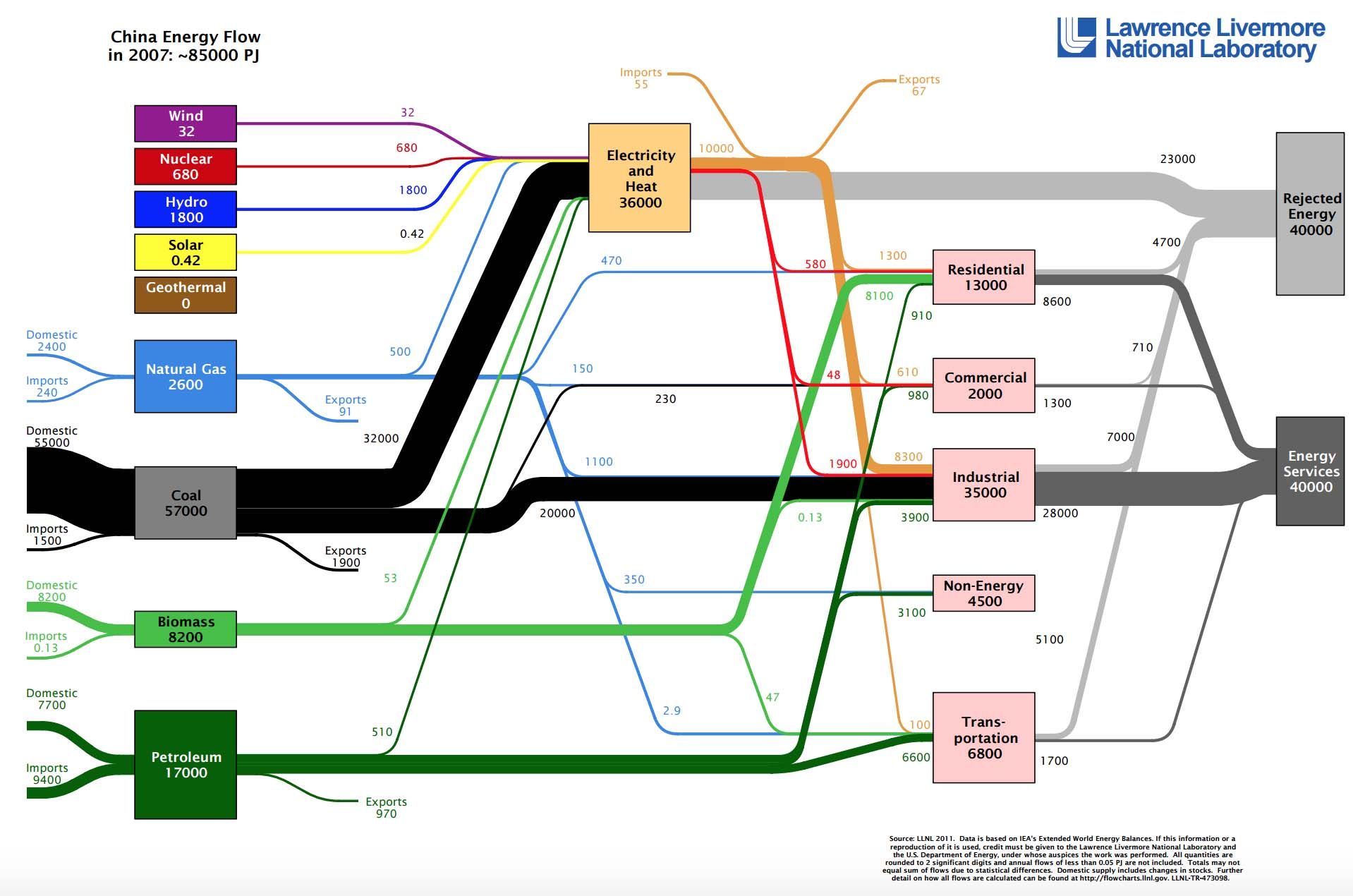
China is an energy monster, mostly because they’re an industrial monster. They’re also a coal-burning beast, burning through almost half of the world’s total coal consumption each year. That 57,000 PJ of coal consumption number is insane—over five times France’s total energy flow.
Saudi Arabia:
North Korea’s energy flow is, unsurprisingly, just weird:

You can check out the full report to see the rest of the countries.
Now let’s move to 2013 and look at the US energy flow. The unit is different here. A quad = 1 quadrillion BTU, which is about 1,000 petajoules.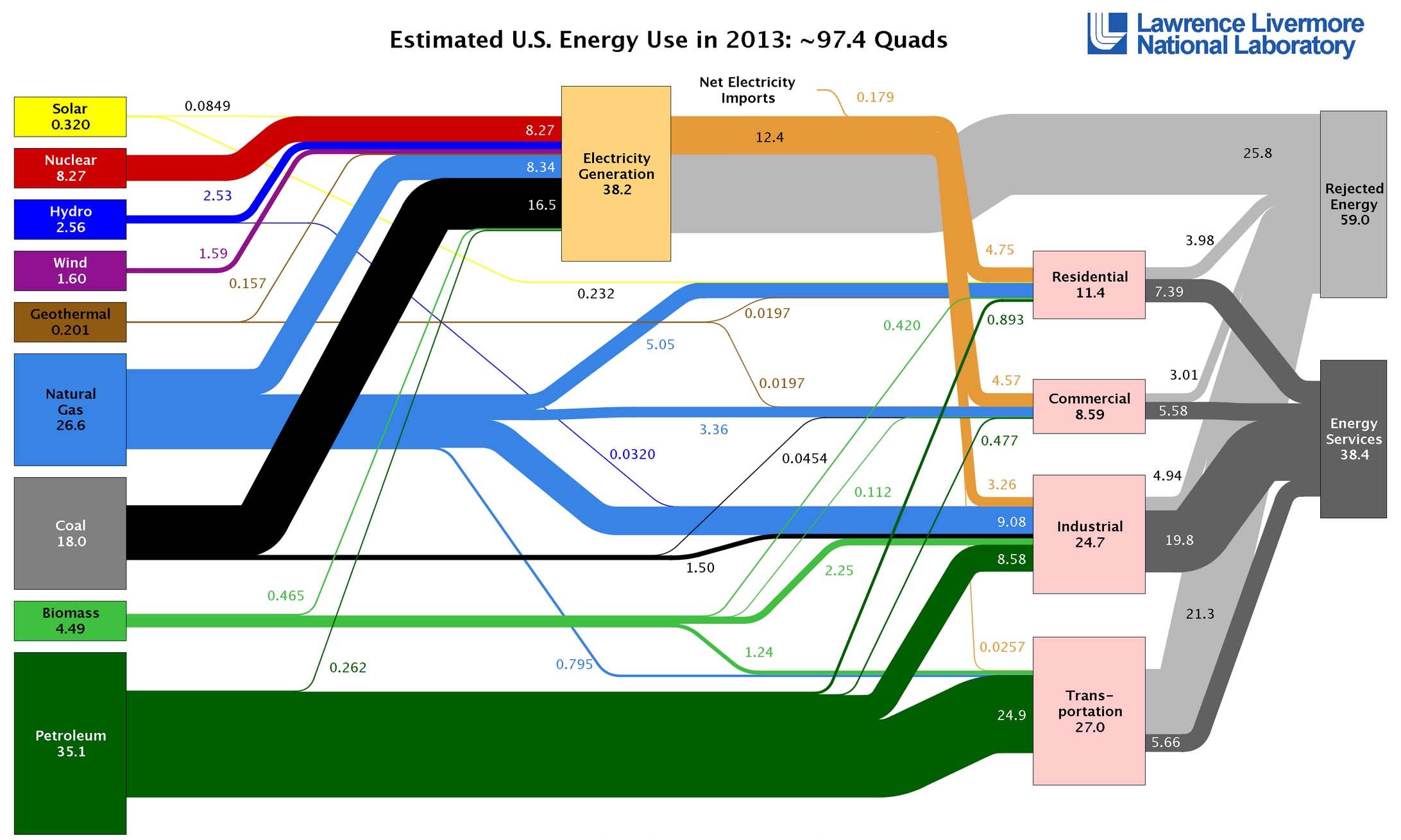
Two things that stand out:
– The US has become a natural gas consumption beast and by far the biggest one in the world.
– The US is even more of an oil-consumption beast—almost double the second biggest oil-consuming country, China, and more than four times #3 on the list, Japan.
To put in perspective how much energy the US uses, I found a country in the world that uses a similar amount of energy as each US state:
Finally, let’s go back to the reason we started with these charts in the first place—to figure out how we’re gonna get from the black part of the timeline to the yellow and out of the fossil fuels area. The LLNL also produces a chart showing the US carbon emissions and where they come from. The US is the world’s second biggest carbon emissions culprit (China is first with 50% more than the US) and the world leader in transportation emissions—so if we can figure out what the US needs to fix, that’s a good start.
Getting from the black to the yellow means getting rid of carbon emissions. Looking at the US emissions flowchart, I see two glaring numbers:
There are many things that need to happen to get us into the yellow zone, but these two figures—which make up 72% of total US emissions—seem like the biggest and most urgent problems to address:
1) Electricity production throughout the world makes up about 40% of the total energy flow, and roughly two thirds of electricity production comes from burning carbon-emitting fossil fuels, most prominently coal. Or, put simply: Electricity production is huge and mostly dirty.
2) Transportation makes up a large chunk of the world’s energy flow, including near a third in most developed countries, and almost all the world’s transportation runs on petroleum. Put simply: Transportation is huge and almost entirely dirty.
We’ve spent this post zoomed far out on all of this. Now it’s time to zoom in, and we’ll zoom in on the second major problem listed above—transportation, and in particular, cars. Transportation covers planes, trains, ships, trucks, and cars—but cars cause more carbon emissions than the other four combined, and without major changes, car emissions are expected to rise by over 50% by 2030. By zooming in on one major piece of this puzzle—car emissions—and examining how it became a problem, why it’s still a problem, and the way we might solve that problem, we’ll get a better sense of what this entire struggle is really made of.
Meet the world’s first car owner.15
That’s the Chinese Emperor, Kangxi, in his driving clothes. He got the car in 1672, when he was 18. It was given to him by the first car-maker.16
That’s Ferdinand Verbiest, a Flemish Jesuit missionary who apparently didn’t have time to get his hands in a normal position before the painter had already finished. Verbiest spent his life in China, where, in 1670, he became the empire’s chief mathematician and astronomer after winning a contest against a rival over who could create the most accurate calendar—the loser would be “cut up into bits while still alive”17. In his new position, he started inventing things, one of which was the first-ever car, which he made as a toy for the emperor. It was sleek.18
It wasn’t big enough to hold a driver, but by figuring out how to boil steam and aim it at a spinny wheel that rotated a gear that would turn the front wheels, Verbiest had created the world’s first known self-propelled vehicle.
Verbiest’s car would remain world class until 1769, when French inventor Nicolas-Joseph Cugnot finally figured out how to improve upon it by inventing the first car that could hold a driver.19
Next came this little sassypants:20
That’s François Isaac de Rivaz, who in 1807 invented the world’s first internal combustion engine and a little vehicle to go along with it.21
With a steam engine, the fire burns outside the engine and heats steam inside the engine to make it work. So it’s an external combustion engine. An internal combustion engine cuts out the steam and burns the fuel inside the engine itself to generate power.
But it would take until 1886 for the arrival of the first actually-useful car, invented by German engineer Karl Benz, along with his wife Bertha Benz, who I might love, and his mustache.22
Their car is considered the world’s first real automobile—the Benz Patent-Motorwagen.23
The car cost $1,000 ($26,248 today), had three wheels, and was powered by a primitive version of a modern internal combustion engine.
A few years later, across the world in the US state of Michigan, a young farm boy named Henry Ford, deciding that taking over his family farm would “bore his dick off [sic],” applied for a job to work for Thomas Edison. Edison’s company was busy rolling out electrical generating systems to power US cities, and working on these, Ford got good at working with the steam-powered engines the company used to make electricity. In his spare time, Ford sat in a little workshop next to his home playing around with the still-novel concept of the internal combustion engine, and in 1896, at the age of 32, he came up with what he called the Ford Quadricycle, powered by a simple internal combustion engine.24
Becoming increasingly obsessed with building self-propelled vehicles, Ford quit his job in 1899 and first formed the Detroit Automobile Company, which failed, before forming the Henry Ford company in 1901. But Ford soon left the company over a dispute with the company’s investors, who then renamed it Cadillac Automobile Company, and in 1903, he went on to partner with a guy named Alexander Malcomson to create a company called Ford & Malcomson, Ltd., which was later renamed Ford Motor Company. Super annoying for Malcomson.
Ford and his new company charged ahead making gas-powered cars, but at the time, gas cars were hardly the norm. Cars were a new technology, and at the beginning of the century, 40% of American cars were powered by steam and 38% were electric—gas cars only made up 22% of the American market.
These numbers make sense. Steam-centered external combustion was the older and best-understood technology of the three and was initially the most common way to power a car. Its fancier new cousin, the internal combustion engine, powered by burning gasoline, cut out the middleman and burned fuel more efficiently. But it’s no surprise that the quickest up-and-comer type of car was the electric car. It was 1900 and electricity was at the core of all the coolest, newest technology.
The 35 years between the mid-1860s and the turn of the century had just witnessed an electricity revolution, driven by inventors like Thomas Edison, Nikola Tesla, Alexander Graham Bell, and George Westinghouse, during which the world went from normal to positively magical. The first magic happened in the middle of the century, when the telegraph used long-range electricity to communicate with people really far away, and in 1866, the first successful cross-Atlantic telegraph message was sent, allowing Europe and the US to magically communicate with each other instantly. The magic revolution hit full force in the late 1870s. The first telephone call happened in 1876, followed by the first time in human history someone could record sound and then play it back, in 1877. Light bulbs began to light up city streets in the early 1880s, and by 1896, the first electrical grid brought widespread electricity into people’s homes. Also in 1896, the first primitive motion picture went on display in New York, and the first wireless transmission of a human voice—the birth of the radio—went through in Brazil in 1900. Meanwhile, magical horseless cars were appearing on the streets, and only a few years later, in 1903, the Wright Brothers would take humanity’s first heavier-than-air flight. It’s hard to imagine how insanely cool a time this must have been for everyone.
And if you were alive around the year 1900, you’d probably equate modern tech with electricity, much the way we today equate modern tech with computers, smart phones and the internet. Edison and Tesla were their Bill Gates and Steve Jobs. The idea of powering transportation with a fiery engine dated back to the earliest locomotives almost 100 years earlier, which would seem about as modern to a person in 1900 as black-and-white silent films seem to us today. By 1900, you weren’t supposed to have to deal with how the energy sausage is really made anymore—the burning fire happened in some remote generator now, allowing consumers to only have to interact with the silent, clean, convenient magical butler—electricity.
So if someone in the year 1900 had to bet on the outcome of the battle between external steam combustion, internal gasoline combustion, and electricity as the future standard for powering cars, they’d have probably put their money on electricity. And at the time, electricity was not only winning the battle over gasoline with far more cars on the road, but the world’s most prominent inventors, including Edison and Tesla, were pouring their efforts into an electric car future. Early in the century, the New York Times referred to the electric car as “ideal,” citing it as quieter, cleaner, and more economical than the gas car.25
But ideal wasn’t the driving force of the early auto industry—scalable was. Cars were, up until that point, fairly impractical toys for rich people. There would be time to idealize everything later—the first step was to figure out how to make the car fast, sturdy, and most importantly, affordable. Money and brains poured into car technology from all over the world, and in 1908, Henry Ford and his five-year-old company came out with the car that launched the automotive industry into the stratosphere: The Model T.26
Before the Model T, there had been big problems with both electric and gas vehicles. Electric had shorter ranges and longer refueling times. Gas cars were loud, hard to start, and spewed smoke like it was 1802.
But Ford was a masterful industrialist, and by coming up with the concept of making cars by moving assembly line instead of hand-crafting them, he dramatically brought down costs and created America’s first car for the masses. In 1912, engineer Charles Kettering invented the electric car starter, eliminating the need to laboriously and dangerously hand crank your gas car on, and the newly invented muffler significantly reduced gas engine noise. Suddenly, a lot of the things that sucked about gas cars didn’t suck anymore—and they had become much cheaper than electric cars. Ford’s Model T took over America, and by 1914, 99% of new American cars ran on gas. By 1920, electric cars dropped entirely out of commercial production.27
This was not an inevitable outcome. The future of cars had been up for grabs, and Ford had simply outsmarted his competition. Burning fuel was the way of the past and electricity was the way of the future—but Ford had created a provable, profitable business model for making cars, one that didn’t yet exist for electric cars, and it quickly became too much of an uphill battle for electric car makers to try to turn the tide. So they stopped.
___________
Now it’s a century later. The most primitive local telephone call through a wire has become a person in Delhi being able to take a slab of glass out of his pocket, tap it with his finger, and instantly be talking to, and looking at, his friend in Sao Paulo. The grainiest, choppiest black-and-white silent movies have become Pixar. Mixing chemicals in a lab has become splitting atoms in the Large Hadron Collider. The Wright Brothers’ 12 second, 120-foot flight has become routine trips 250 miles up to the International Space Station.
But instead of me finishing that paragraph with, “The primitive gas-burning car has become [something rad we can’t even imagine],” I have to finish it with, “The primitive gas-burning car has become the better gas-burning car.”
As I said, if you were alive in 1900, you’d have probably thought the idea of an AC induction electric car motor was awesome and futuristic, and the internal combustion engine, which was only an incremental advance from the early locomotive steam engines invented a century earlier, was kind of cool but not especially futuristic. But we’re not alive in 1900, we’re alive in 2015, so when we look at the modern gas engine that’s in all of our cars, and we see pistons moving back and forth because of something hot exploding inside their cylinders—28
—they should seem outrageously ancient. Quick aside:
Tim Makes Passionate Car People Even More Furious By Describing How a Car Engine Works in a Clearly-Non-Car-Person Way Blue Box
Welcome to the Tim Makes Passionate Car People Even More Furious By Describing How a Car Engine Works in a Clearly-Non-Car-Person Way Blue Box. Here’s the deal:
The animation above is of a four-stroke, four-cylinder engine. The four cylinders are those four tubes the pistons are moving up and down inside of. Each time a piston slides up or down, that’s called a stroke, and the fuel-burning happens in a four-stroke cycle:
1) The Intake Stroke: This is the part where the piston is moving down and there’s blue stuff above it. The blue stuff is air that’s being sucked in along with a small amount of gasoline that’s fired in at just the right time by the fuel injector.
2) The Compression Stroke: This is the stroke where the piston moves up and as it does, the blue stuff turns orange. What’s happening is that the valve that let the air in on the intake stroke has now closed and as the piston moves up, there’s nowhere for the air/gas mixture to go, so it just compresses really tightly.
3) The Power Stroke: This is the stroke I feel like passionate car men talk about with a little twinkle in their eye. In the animation, this is where the piston moves down and there’s orange above it which then turns gray by the end. The previous compression stroke has squeezed the air and gas tightly, and at the top of that stroke, the spark plug at the top of the cylinder emits a spark which ignites the compressed air and gas on fire and creates a little explosion. This explosion blows the piston back downwards. This stroke is where the power of the car engine comes from.
4) The Exhaust Stroke: This is the part where the piston pushes the gray stuff up and out of the cylinder. The gray stuff is exhaust—i.e. smoke because you just lit a campfire in that cylinder—that then makes its way out of the car’s tailpipe. This smoke consists of mostly non-toxic gases with a little carbon monoxide and other poison mixed in for fun. Also in the exhaust is the carbon dioxide that just got created during the explosion, which allows the long-buried carbon in the gasoline to happily re-enter the Earth’s atmosphere after the most boring 300 million years ever underground.
The furious back-and-forth motion of the pistons work together to forcefully turn what’s called a crankshaft—that metal bar contraption they’re all connected to below—which creates the turning motion that eventually turns the car’s wheel axles. I think.11
(For more info: first two minutes of this video shows this all in action, and this is aesthetically pleasing.)
Now. I’ll admit that car engines are cool. And I can see why some people are kind of obsessed with them. But when I look at these two animations next to each other—
1815 locomotive engine:
2015 car engine:
—they look too similar to be 200 years apart.
“Hot explosions in cylinders pushing pistons back and forth to force metal bars to turn wheels and sending the resulting smoke billowing out of a pipe” sounds like an old-fashioned technology, and it’s just very odd that we’re still using it today. We get used to the world we live in, whatever that world is like, but if you examine history and take a big step back, some things suddenly make no sense. And this is one of them.
So the question we need to ask is why.
If electric motors were the more advanced technology—if they were considered ideal because they were quiet, clean, and took advantage of cutting edge technology—why did the world give up on them? In 1900, neither electric nor gas cars were viable for mass adoption—both needed a few key technological breakthroughs. The key breakthroughs needed for gas cars happened first—but why was that reason for us to just settle, permanently, for the more primitive technology and the one that, over time, would make our cities smoggy and change the chemical makeup of our atmosphere? If 20th-century human invention could go from the Wright Brothers’ 12-second flight to the moon in just 66 years, surely advancing battery technology enough to bring electric car prices and charging times down while increasing range shouldn’t have been beyond our scope. Why did innovation and progress in something as important to the world as car-powering technology just stop?
This question could be asked about other parts of the bigger story of the Fossil Fuels Era. You could just as easily puzzle over the question, “America’s first electricity power station, Edison’s Pearl Street Station in Manhattan, first lit up in 1882, powered by burning coal—how is it possible that in 2015, burning coal is still by far the primary way humanity produces electricity even though we’ve known for decades that it’s not an optimal or sustainable long-term method?”
The problem with the question “Why did X technology stop moving forward?” is that it’s misunderstanding how progress works. Instead of asking why technological progress sometimes stops, we have to ask the question:
Why does technological progress ever happen at all?
The mistake of the first question is the intuitive but incorrect notion that technology naturally moves forward on its own over time—it doesn’t. I can tell you this for sure, because my Time Warner DVR has the exact same horrible user interface it had in 2004. The way technology works is that by default, it stands still, and it moves forward only when something pushes it forward.
We often have the same intuitive misconception when we think about evolution. Natural selection doesn’t make things “better”—it just optimizes biology to best survive in whatever environmental circumstances it finds itself. When something in that environment changes—a predator mutates and becomes faster, a certain type of food becomes scarce, an ice age rolls in—it means species that were previously optimized to the environment no longer are. The environmental change alters the natural selection criteria, which applies a pressure on the species as it is, and over time, the genetics of the species will react to the pressure by changing in order to optimize to the new environment.
When it comes to technology, a totally free and open market is the natural environment. But unlike the world of species, which is the eternal Wild West, human societies have another factor in play—a god-type force called government. So if we’re trying to figure out what makes technology move and change, we have to look at two sources of pressure: natural market conditions that ebb and flow and apply continual new pressures on all the actors within, and the “god” on top who can artificially change the environment below to create manufactured pressures. Let’s examine both, starting with government:
1) Pressure From Government-Induced Environment Changes
The nature and power of a market’s government-god varies significantly throughout the world. In North Korea, it is a Biblical-style, all-knowing, all-seeing, all-powerful ruler of the universe to the point where there is no natural market environment—just the one god created and maintains. In Scandinavia, god is a wealthy power mom and the market is nestled in her warm bosom of safety and opportunity. In Central Africa, god made a lifestyle change and got a new job, working for the wealthiest families—huge step up the ladder for him.
In the US, god has an identity crisis, alternating between feelings of pride and self-loathing. It wants to have the best country, but it’s standing on the street corner alone yelling out in an argument with itself about the right way to do that. When the US government (or a government like it) wants to play god and alter the American natural market environment to apply certain pressures in certain places, it uses three main tools: funding, regulation, and taxes.
Funding: In order for government funding to lead to major progress, there has to be a lot of it, and in an open democracy, that only flies when the nation needs to do something so important that everyone agrees on it—like in the 1960s, when the fear of losing global influence kicked the US government’s adrenaline in and it put a man on the moon. Likewise, significant US military funding is something the American electorate can agree on enough that it receives tremendous funding and plays an important part in advancing technology in a number of industries. In most cases, though, a divided democracy is too paralyzed by conflicting interests and political squabbling to be the main driver of a serious tech revolution.
Regulation: Another democratic government muscle is its ability to make rules—laws, restrictions, quotas, etc. These can be effective at pushing through minor changes—the seatbelt and airbag are both products of government regulation. But at least when it comes to the car industry, I’m having a hard time thinking of instances of major technological leaps caused by government regulation.
Tax Code: The government often uses the tax code to add its own economic pressures into the free market. Again though, while this can be effective for nudging something in a certain direction, it doesn’t tend to lead to sweeping advances.
Of course, America is in a big fight about this, with fiscal liberals typically feeling a lot more optimistic about government’s ability to play a positive role in moving things forward than fiscal conservatives. But I think both would agree that major tech progress being forced forward by the government is more the way of places like the Soviet Union and modern-day China where government has a lot more power. The incredible innovation that often emerges from open democracies tends to come from pressures from below, in the bubbling cauldron of the free market—
2) Pressures From Natural Market Forces
In the natural world, to catch food and stay away from predators, animals will optimize by becoming fast and elusive runners. When food on the ground becomes scarce, species will feel the pressure of hunger and over time, their genetics will re-optimize by developing good bodies for climbing or long necks or wings. A running species that becomes a flying species hasn’t become better—just better fit for the current circumstances. In the world of species, the definition of optimization is simple because the end goals are simple: the core needs of biological creatures are always the same—to self-preserve and reproduce. So optimization in the natural world always has the same definition: to adjust in a way that makes you mostly likely to self-preserve and reproduce.
In order to understand what optimization means in the market, we need to know what the core goals are of the actors there. Of course, people are also biological creatures, and self-preservation will always be at the top of the list—if you’re hungry, cold, or sick, fixing that will be the core goal. But for people whose base needs are being met, what are the yearning desires that then lie at the core of their motivation? What does “pursuing your self-interest” mean for them?
Well, it depends on the culture. In certain cultures, the fear of failure is so strong that it outweighs desires like glory or great fortune, and the primary inner drive becomes to just make sure you’re passable. In others, the deepest drive of the people might be religious salvation, community or family service, a leisurely lifestyle, or spiritual enlightenment.
When it comes to technological advancement, those motivations aren’t likely to get you there because thinking up tech innovations isn’t a helpful step on the path to optimization for those people. So if we want tech progress, what kind of yearning do we want people to feel?
I think the ideal mix is a two-part cocktail:
First ingredient: Greed. In a perfect, fair, open market, greed works great as the core lifeblood motivation. The way capitalism theoretically works is that the more real-world value you create, the more money you’ll make. So companies in a competitive landscape will put their effort into creating better and better products and services in order to optimize, which for them means making as much money as they possibly can. Individual people are greedy as a means to all kinds of ends—a lavish lifestyle, personal freedom, security, admiration, power, sex—but what they want is irrelevant. As long as their burning desire makes them really want stuff, their drive to optimize will move technology forward. Greed is a double-edged sword though—to be beneficial, greed has to be contained inside a high-integrity, meritocratic, free market. If it’s not, greed will turn into the enemy of progress, because the more vulnerable the system is to corruption, the more the greedy on top will be able to game the system to ensure their own long-lasting victory.
Second ingredient: Raging ambition. Greed can lead to steady forward progress, but in order for progress to leap forward, a second ingredient is usually key: a burning desire to do something great. Again, the underlying reasons for this kind of ambition can vary. Sometimes it’ll be an ego-driven desire—to be famous and renowned, to leave one’s mark, to be thought of and posthumously remembered as great. Other times the ambition will be fueled by a borderline-insane level of confidence and optimism that gives someone the gall to be idealistic. These are the yearnings of the hungry underdog.
An established industry full of existing winners running on greed is like the highest layer of trees in a crowded rainforest. They’ll push upward only as needed, elbowing each other for little gains and victories as they vie for sunlight, mostly just trying to keep their spot in the canopy. Greed just wants sunlight—it doesn’t care how high up it is when it gets it.
But below, the hungry underdog burns for sunlight and will spend 100 hours a week trying to figure out how to get it. When the breakthrough comes, the underdog bursts up through the canopy into the open sky and spreads its leaves out wide. Suddenly, the trees that had been on top are blocked from the sun. Greed is then replaced by the much more powerful drive of survival, and innovation kicks into high gear as they scramble upwards for their life. The environment has changed—it’s been disrupted—and in this new world, created by the underdog disruptor, companies have to innovate in order to re-optimize. Some end up back on top, others die—and at the end of it all, technology has jolted forward. We all witnessed an example of this when Apple rocketed through the mobile phone canopy in 2007 and forced all of the other companies to make a smartphone or die. Samsung managed to get itself back into the sun. Nokia did not.
With all this in mind, let’s go back to the car industry and our original question:
Why hasn’t the car technology forest moved upward over the past century?
I see two primary reasons:
1) Insanely high barriers to entry—so no leaps forward caused by hungry underdogs
Try to think of something ickier and harder than starting a car company.
First, before you can sell one product, you’ll need to put down an absurd amount of capital to buy a factory, figure out how to design a car and all of its parts, build a prototype, use that to raise a lot more money, get a much bigger factory and hire thousands of people, and pump many millions of dollars into marketing to tell the world that your company exists. And you probably need to be incredibly rich and risk-tolerant yourself since very few people are zany enough to invest money in a startup car company.
Second, in order to be profitable, you have to sell at a high volume. Cars are too expensive to make and margins are too thin to only sell a few each year. So for this to be a good idea, you not only have to create an awesome car, but one that a ton of people will want to buy.
Third, gas cars are already well-optimized—if you want to aggressively burst through the canopy like an underdog without any brand awareness needs to, you have to create a much better type of car than what’s out there. In the case of cars, that probably means addressing the core of the car itself and the thing that’s been stressing everyone out with its billowing emissions—the engine. But since no one has really done this yet, it means you need to not only create the first successful startup car company in a long time, you need to create the first startup to ever succeed at making whatever type of car you’re creating. And since you’ll be there first to do it, you’ll have to put a huge amount of time and money into innovation research and development and bear the brunt of the invention costs for the whole industry. You’ll also have to bear the marketing costs to educate the world on why they should want this new type of car—that’s a one-time expense and once it’s done, other companies will be able to ride on the consumer demand you spent a ton of money building.
So it’s not surprising that the last successful startup car company in America was Chrysler in 1925—90 years ago. It’s basically an impossible endeavor.
And without any threat from below on the forest floor—from the wild innovation of scrappy entrepreneurs with nothing to lose—the car industry has had the luxury of calmly sunbathing in a tight canopy quilt, making only incremental advances, only when they’re needed. But there’s a problem here too—
2) A glitch in the car market separates car company optimization from what’s best for the world.
As I mentioned above, greed works nicely as an optimization criterion if the market is perfect—open, accurate, and fair.
Greedy companies will make their decisions based on whatever the best way is to optimize to their environment—i.e. How can we make the most possible money? But a company’s drive for maximum money is only beneficial to society when the company’s profit is tightly and accurately correlated with the amount of net positive value its product or service provides to society.
If I start a lemonade stand, every time I give someone a delicious cup of lemonade, they’ll be likely to recommend me to their friends and become a recurring customer. I provided positive value and my business’s success went up with it.
Success = Value Provided. Incentives are aligned.
If another customer comes to the stand and I give him a cup of lemonade with a fly in it, he won’t come back and he’ll tell his friends not to go—I caused harm and my success went down.
Success = [Value Provided] – [Harm Caused]. Incentives still aligned.
But what if I then discover a chemical I can spray on my lemonade that prevents flies from landing on it. The chemical is tasteless, but I know that drinking it regularly will cause customers immense harm a few decades down the road. Customers won’t experience the harm in the present, so it won’t affect their opinion of my lemonade or the success of my business.
Success = [Value Provided] – [Harm Caused].
The harm caused is now an unaccounted-for cost, also known as a negative externality, and my incentives are no longer aligned with the customer’s best interests. If all I care about is greed and maximizing profit, I will continue to use the chemical, because I’m economically incentivized to do so.
This kind of negative externality is how tobacco companies got away with murder for so many decades. The long-term cost to customers’ health was unaccounted for because customers were ignorant to the consequences, the negative effects were years away, and there was no regulatory penalty in place to charge for the harm. Thinking purely from a greed-optimizing perspective, cigarette companies acted completely rationally. They kicked up nicotine levels in cigarettes and added shards of glass into filters to create tiny cuts and increase nicotine absorption, which caused further harm but increased demand—but since the harm was unaccounted for, this was a pure net positive for the company. And when anti-tobacco campaigns started to educate customers on cigarette harm—which attaches the harm to the cost of scared customers and lower demand—the tobacco industry hired low-integrity scientists to discredit the negative campaigns and muddle the message. Awareness would get there eventually, but the longer they could delay and keep the harm hidden, the better off they’d be from a greed standpoint.
People call this evil, but all it really is is an industry acting in its own best interests within the parameters of its environment. Greed is a simple motivation—it takes whatever it can get, and it’ll push all available limits it can in order to fully optimize. I used tobacco companies as an example, but you could easily tell the story with fast food, radiation-emitting consumer electronics, politician behavior, the finance industry, and many others.
In the auto industry, CO2 emissions are the negative externality. If you have a cheap and easy way to build cars that dump garbage into the atmosphere and no one makes you pay for it, why would you ever change anything?
It’s the same story as cigarettes. Instead of the tobacco industry and the cigarette companies who support it, you have the oil industry and the car companies who support it. Instead of short-term emphysema, you have short term city smog. Instead of long-term harm to people’s health like lung cancer, you have long-term harm to the human way of life like underwater coastal cities.
A lot of people have written about the hidden cost of carbon emissions, and many of them, on both sides of the political spectrum, have proposed a logical solution: a revenue-neutral carbon tax.
A revenue-neutral carbon tax is revenue-neutral because any increase in government revenue as a result of the tax would be offset by an equal decrease in something else like income taxes. This makes it a politically moot proposal.
The tax could be applied at any point along the supply chain from oil extraction to the gas pump and the effect would be the same—it would either become more expensive to drive a gas car, less profitable to be in the business of gas, or both. With a carbon tax in place, when you’re contributing to the carbon problem, you’re also paying for it—which incentivizes consumers and companies to explore alternatives. This wouldn’t be the government meddling in the market—it would be the government fixing a glitch in the market.
Instead, the government offers tax breaks to people for buying an electric vehicle and subsidies for the renewable energy industry, which is like a town full of businesses who throw their trash in the street, and the government reacting by paying businesses to stop doing that, instead of just charging businesses for doing it. Other times, the government tries to force emissions downwards by forcing car companies to create a minimum number of zero-emissions cars—with limited effect. Jimmy Carter and Bill Clinton both tried this, to some extent, and both times the next president (Reagan and Bush) removed the regulations upon taking office (ironically, the Clinton mandate for more hybrid cars accomplished nothing in the US, but it scared the shit out of Toyota, who began furiously innovating and created the Prius). Another time, in 1990, the California government tried to institute its own zero-emissions regulations, which the car and oil companies fought until they finally bullied California out of it and the regulations were removed in 2003.12 The problem is, giant companies have enough influence that any government attempt at making changes through regulation ends up being watered down to the point where it’s ineffective.
When it comes to a carbon tax, the only explanation for not having one seems to be the power big oil has over the US government—because to me, it seems like every politician in either party should be in favor of a revenue-neutral carbon tax. Right?
Without any negative consequence of emitting carbon, optimizing for greed pushes certain car technologies forward, like safety, comfort, and drive quality, because getting high safety and quality ratings is tied to demand—but it doesn’t change anything about carbon emissions, because the greed equation doesn’t currently include that cost.
So the reason why, 112 years after Ford Motor Company’s founding, we’re still using harmful, old-fashioned engines is simple: none of the pressures on the car industry are pushing it to change. The car industry still needs to work hard to optimize in certain areas—that’s why cars have become safer, smoother, more comfortable, and more efficient over the years. But the most glaring flaw of the modern car—that it constantly dumps garbage into the atmosphere—remains untouched, because doing so is free, because big oil’s influence means government keeps allowing it, and because there’s no one from underneath to burst through the canopy and show customers that there’s a better way.
It’s scary. Something really, terribly bad might be happening that could make our actual lives legitimately worse in the future, but we have a prisoner’s dilemma on our hands—it’s much, much better for all of us collectively to make a change, but for each individual CEO, lobbyist, or politician, there’s more to personally gain from maintaining the status quo. People like to say, “this is the world our children will live in and we’re botching it for them,” but for the people with the power to change something, their particular children will be best off if they make the most money possible. The situation is stuck.
A deeply-set, stagnant industry is like a country led by a deeply-entrenched dynasty—it’s hard to penetrate the status quo. But even in the case of the most powerful caste systems, sometimes the right person comes along at the right time and starts the right movement, and a revolution can ignite.
Christie Nicholson remembers meeting Elon Musk for the first time at a party back in 1989.
“I believe the second sentence out of his mouth was ‘I think a lot about electric cars,’” Christie said. “And then he turned to me and said, ‘Do you think about electric cars?’”13
Electric cars seems like an odd thing to spend your time thinking about in 1989. To understand why Musk felt so strongly about them, let’s start by understanding what electric cars are and how they work.
There are a handful of common modern types of cars considered greener than traditional gas cars—namely hybrid cars, plug-in hybrid cars, and electric cars (which we’ll call EVs for “electric vehicles”). There’s also a lot of talk about another type—hydrogen fuel cell cars, which we’ll just call hydrogen cars. The one thing these cars all have in common is an electric motor.
There are two types of electric motors—the AC induction motor and the brushless DC electric motor. Since 98% of people reading this aren’t licking their lips to read a three-paragraph description of the difference, let it suffice to say that they’re the same basic idea:
An electric motor is a pig in a blanket where electricity is sent into the outer bread part (called the stator), which is always stationary, and that electric current causes the hot dog part (called the rotor) to rotate. The rotor is attached to the wheel axle which turns the wheels. Like this:29
How an AC Induction Motor Works Blue Box
One of the two common types of electric motor is the AC induction motor (that’s what Tesla cars use). AC stands for alternating current,14 and induction means there’s no physical contact between the rotor and the stator—electricity in the stator generates a rotating magnetic field which enters the rotor through electrical induction and causes it to spin.
The stator generates a rotating magnetic field by sending electricity through it in a three phase system:30
So there are three different wires each with an alternating back-and-forth pull—just look at any one color and you’ll see it’s just going back and forth. But the three wires’ currents are staggered in just the right way that the point of “pull” in the stator rotates in a smooth circle. When the rotor is added in, this rotating magnetic field causes it to spin:
The idea is that the rotor can never quite catch up to where it wants to be—it’s always “chasing” the rotating field, and that chase is what powers the car. The AC induction motor was invented by Nikola Tesla, and that’s why Tesla Motors is named after him.15
Here are the types of cars that use an electric motor:
Hybrids (also called HEVs for hybrid electric vehicles), like the Toyota Prius, have both an electric motor and an internal combustion engine. You don’t plug a hybrid car in—the gas charges the battery. The battery also gets charge from an electric motor trick called regenerative braking. Normally, all the joules of kinetic energy a car is harnessing when it’s moving are lost when the car brakes and they’re just converted into heat. With regenerative braking, electric cars send some of that kinetic energy back into the battery, holding onto those joules to be used again later. The electric component of a hybrid replaces some of the need to burn gas, increasing the miles per gallon, decreasing the car’s emissions, and saving the driver gas money. Hybrids are a big step up in technology from normal gas cars.
But they still kind of suck. Why? Because they’re only kind of helping the emissions problem, not solving it, and they still need to burn gas to work. As I’ve heard people say, a world 100% full of Prius drivers is still a world 100% addicted to oil.
Plug-in hybrids (also called PHEVs) are a better option. Plug-in hybrid cars, like the Chevy Volt, the Honda Accord Plug-In Hybrid, and the Ford Fusion Energi, allow you to charge the battery at home and typically drive 10-40 miles just on battery power before the gas kicks in. That’s often enough to get most people through most of their day, meaning they may rarely need to use gas.
But if we’re gonna get so close, why not just go all the way?
Hydrogen cars are entirely electric—but they don’t use a battery. Instead, they fill up with fuel at a station just like a gas car—except they fill up with compressed hydrogen, not gas. The hydrogen mixes with oxygen in the air to produce electricity, which it sends to the motor to power the car. They produce no tailpipe emissions because the only byproduct is clean water. Sounds great, right?
Musk, for the life of him, cannot understand how anyone could make an argument in favor of hydrogen cars,16 but it’s confusing because lots of car companies, like Toyota, Honda, and General Motors, are currently pouring big investments into making hydrogen cars. I wanted to understand the disagreement, so I read like 12 articles in favor and opposed to the technology. At the end of it, I’m having a hard time seeing why hydrogen cars would have a more promising future than electric vehicles. For those who want details, here’s a footnote.17
Finally, there are electric cars, or EVs, like the Nissan Leaf, the BMW i3, the Ford Focus Electric, and the Tesla Model S. These are simple—there’s a big battery, which you charge, and it powers the electric motor. No liquid involved.
Now, in theory, EVs make a lot of sense. Forgetting the rest of the car for a second, let’s look at some of the advantages of the electric motor over the internal combustion gas engine:
Electric motors are more convenient than gas engines most of the time. Gas cars have to go to the gas station; EV owners plug their car in every night the same way they charge their phone—no stopping for gas. A gas engine is a lot more complicated than an electric motor, with over 200 parts; an electric motor has fewer than 10. A gas engine requires a transmission, a tailpipe, gears, and a bunch of other grease-covered shit; an EV has none of those things—when you open the hood, it’s more storage space, like the trunk. Gas engines need oil, which means they need oil changes; EVs don’t. The extra complexity means gas cars end up needing a lot more maintenance than EVs.
It costs a lot less to power an electric motor than a gas engine. The extra costs gas car owners incur for oil changes and car repairs aside, the gas engine’s fuel—gas—is much more expensive than the electric motor’s fuel—electricity. Let’s look at the math:
The average electric car gets about 3 miles per kWh18 of electricity, and the US national average electricity rate is 12 cents per kWh. That means that driving a mile in an electric car costs about 4 cents.
The cost of driving a gas car is harder, because gas prices and car fuel efficiency widely vary. The best case scenario for a gas car is unusually cheap gas (let’s say $1.40/gallon) coupled with unusually high fuel efficiency (let’s say it’s a rare gas car that gets 35 mpg). That would produce the same 4 cents/mile that electric cars get. But very few gas car owners ever pay 4 cents/mile. Without being crazy extreme, for the worse case scenario, let’s say a high $4.00/gallon gas and a below-average 15 mpg—in that case, a mile in a gas car costs 27 cents per mile. At a pretty typical 12,000 miles/year, that means at absolute best, gas is tied with electric for cost, and at worst, it costs over $3,000/year more to drive on gas.
The gas engine is one of the two major causes of the energy/climate crisis. We’ve already discussed this—transportation burning oil makes up a third of the world emissions, pollutes cities, and makes nations over-dependent on other nations. The electric motor emits nothing. Yes, it may run on electricity that was produced in a dirty way—but we’ll get to that later.
So that’s why Musk told Christie Nicholson that he thinks a lot about electric cars. The electric motor is clearly the easier, cheaper, and more sensible long-term plan for powering cars.
But when the electric motor made its first appearance over 100 years ago, there were serious drawbacks that prevented it from becoming the norm—and since electric cars went out of production back then, little time or money has been spent trying to fix those issues. There tend to be three age-old concerns about the viability of the electric car:
EV Concern 1) Range. This is really three issues rolled into one:
A) Will the battery life be too short for long drives, limiting an EV to a car only for local driving?
B) If I’m out and about and need to recharge my battery on the road, is there anywhere to do it? Or will I end up stranded?
C) If I do find a charging station while on the road, will I have to sit there for five hours while it charges?
These issues are such a prevalent concern among potential EV-owners that they have their own term: range anxiety.
EV Concern 2) Performance. The most common electric vehicle you’ll see around today is the golf cart. Which doesn’t excite car owners very much. No one wants a car that drives like shit, and when people think about zooming acceleration, they tend to think about powerful gas engines, not electric motors.
EV Concern 3) Price. Ever since the beginning, EVs have cost more than gas cars, mainly because of the high cost of the battery.
Back in 1910, people cited these exact same three concerns over electric cars, and they’re part of the reason gas cars won the day. Gas cars had had their own major problems, but Ford had figured out how to make them viable—something no one has yet done for the electric car.
I asked Musk about his opinion on Henry Ford. He said, “Ford was the kind of guy that when something was in the way, he found a way around it, he just got it done. He was really focused on what the customer needed, even when the customer didn’t know what they needed.”
When he decided in 2003 to stop thinking about electric cars and start making them, the odds weren’t in Musk’s favor. There were the high barriers to entry that had prevented any startup car company from succeeding in almost a century; there was the unaccounted for cost of carbon emissions, which made starting an EV company like trying to stand out on a basketball court as a rookie when all the players except you can foul with no penalty; there was the gargantuan oil industry, which would do everything in its power to stomp on any effort to make it obsolete; and on top of that, the EV was a new kind of car whose development had essentially been on pause ever since EV makers threw in the towel a century earlier, and a daunting and costly catch-up process would lay ahead—the three concerns listed above would all need to somehow be addressed for this to have a chance.
The overarching question was, had electric cars never had their day because of irreconcilable issues? Or had the right person—the Henry Ford of EVs—just not come along yet?
___________
Car companies aren’t supposed to start in Silicon Valley, and Silicon Valley startups aren’t supposed to make cars.
But the electric car industry is not your grandfather’s car industry. And in 2003, it wasn’t anyone’s car industry. After the brief bubble of new electric cars in California in the 1990s between the year the state passed the Zero Emissions Vehicle mandate and the year they were bullied into repealing it, the electric car industry had withered into the oblivion of the scattered California garages and tech labs of car geeks. But big things have emerged out of small groups of cutting-edge California geek labs. Apple. Microsoft. Google. So why not the modern electric car industry?
One of these little car technology companies was AC Propulsion, and while carmakers in Detroit, Tokyo, and Munich continued to not realize that electric cars were clearly the future, the guys at AC Propulsion were experimenting away, quietly making one giant EV breakthrough after another.
One day last week, I cold called AC Propulsion and accosted their CTO, Paul Carosa, who had been there since the beginning. He was too polite to figure out how to get off the phone with me, so he told me about those years in the late 90s and early 2000s when they created their fanciest car to date—the tzero (pronounced t-zero). AC Propulsion had figured out two huge things:
First, the tzero was fast—it went 0 to 60 in 4.9 seconds, which was crazy fast for an electric car and put it on par with the fast gas cars.
Second, they had made big progress on an enormous EV shortcoming by getting innovative with the battery. Previous EVs had used lead-acid batteries, which were heavy and limited. AC Propulsion realized that the laptop and mobile phone industry had been pouring development into making small 18650 lithium-ion batteries increasingly efficient, and that those batteries had gotten really advanced. 18650 batteries look like AA batteries, which seems like an odd match for a car, but by lining up a few thousand of them in a big battery case, they had just created by far the world’s best ever car battery. EVs had always been limited to a 60 or 80 or maybe a 120-mile range. The tzero could go 250 miles on a single charge.
In 2003, a California engineer named JB Straubel was then tinkering around with EVs himself, met Musk to ask for funding for a car project he was working on. Soon after that, Straubel brought Musk by the AC Propulsion office to see the tzero. Musk was blown away. Musk had suspected for a while that EVs were the way of the future, and now that he saw the possibilities with his own eyes, he was convinced.
At the time, he was already running SpaceX and trying to colonize Mars, so launching a startup car company wasn’t something he could really fit into his calendar. He really wanted the world to see the tzero because he was sure it would excite people and help to stoke a new wave of EV interest—and he tried to convince the AC Propulsion guys to bring the tzero to market, with his funding, but they didn’t want to deal with that because it sounded icky. Instead, AC Propulsion introduced Musk to a group of three other entrepreneurs who had also recently approached them with a similar idea and had also been rebuffed. Those three guys, who included Martin Eberhard and Marc Tarpenning, had come up with the idea of licensing AC Propulsion’s technology and bringing it to market themselves as a new company called Tesla Motors19—but to make any of this real, they needed money. It was a perfect match, so they decided to make a run at it together. Musk, who could only dedicate part time to the project, could fund the effort, become Chairman and maintain a strong influence, but by making Eberhard CEO, he could focus on SpaceX with the bulk of his time. And Tesla was on its way.
The group formed a team and started figuring out how to be a car company. One big problem they had was that this was a new technology, and the R&D costs early on for a new technology drive up the price of the product—that’s the same reason the very first cell phones and computers started out really expensive. Except in those cases, they were the first of their kind, so the product could be super expensive and still sell. Because perfectly good, affordable gas cars already exist, it wouldn’t work to come out with the equivalent quality of a $25,000 gas car for $100,000+. So this became the business plan:
Step 1: High-priced, low-volume car for the super rich. Come out with the expensive first product, but make the car so fancy that it’s worth that price—i.e. just make it a legit Ferrari competitor and then it’s okay to charge over $100,000 for it.
Step 2: Mid-priced, mid-volume car for the pretty rich. Use the profits from Step 1 to develop the Step 2 car. It would still be expensive, but more like a $75,000 Mercedes or BMW competitor instead of Ferrari.
Step 3: Low-priced, high-volume car for the masses. Use the profits from Step 2 to develop a $35,000-ish car that, after the government’s $7,500 EV tax credit and the savings on gas, would be affordable to the middle class.
It’s kind of a Hershey’s Kiss business plan:
The overarching mission wasn’t to build the biggest car company in the world. It was to solve a bunch of long-standing EV shortcomings and build such an insanely great car that it could change everyone’s perception of what an EV could be and force the world’s big car companies to have to develop their own line of great EVs. Their end goal, and the company’s official mission, was “to accelerate the advent of sustainable transport by bringing compelling mass market electric cars to market as soon as possible.” In other words, EVs are gonna happen, but we’re gonna make them happen a lot sooner. Sooner, in this case, is important, because it means carbon emissions decrease earlier and the long term effects of them are much less damaging.
So they got working. And four years later, they had their Step 1 car, the Roadster:31
With the Roadster, Tesla wasn’t trying to make their long term car (one Tesla employee told me that from the beginning, Musk would make sure everyone knew that the company’s long-term mission “was not to make toys for rich people.”) They just wanted to build something awesome to A) show the world how great an EV could be, and B) generate revenue to develop their Step 2 car. So they didn’t start from scratch on the body design, instead basing it on a Lotus Elise.
The Roadster didn’t change the world—no $110,000 car ever could—but it sent a message to the industry that Tesla was for real. You may not have heard of the Roadster when it was announced in 2006 or when it started shipping in 2008, but some of the major car companies took notice—Nissan soon launched the all-electric Leaf and GM launched the plug-in electric Chevy Volt soon after the Roadster’s appearance (Bob Lutz, who was Chairman of GM at the time, openly credits Tesla for their decision to make the Volt, saying that after the Roadster unveiling, he went to the GM board and asked, “If a little company in California can do this, why can’t we?”).
But there were some pretty big problems with the first product. Finishing the car was taking way longer than planned, the cost of making each Roadster was way higher than planned, and the early shipments often had defects. This made Musk sad, so he and the board fired Eberhard as CEO, which made Eberhard sad.20 Just as this was going down, the most inconvenient thing ever happened—the 2008 recession—which made the entire car industry sad, but especially Tesla, who didn’t yet have brand recognition and wasn’t yet profitable because of all the upfront investment they had been pouring in. A crippling recession is never helpful, but it was really, really bad timing for Tesla.
Musk had hired a second CEO, but a year in, in late 2008, the company was in one of those movie scenes where the person’s been badly wounded and clearly about to die and there’s this dramatic dialogue scene and the dying person is saying some last words and every time they pause for a second the audience is like, “Is that it? Are they dead? Oh no they just talked again I guess there’s one more line.” Musk, who wasn’t enjoying the drama of the scene, finally was like, “PAUSE THE MOVIE QUICKLY PAUSE IT PAUSE IT” and took over as CEO,21going into full adrenaline mode to try to keep the company alive. And as mentioned in the last post, SpaceX was in the same movie at the same time playing the same role, so Musk’s life was like this:
But enough people had been impressed enough by Tesla that a couple key investments at critical moments came in and kept the company alive, and at the end of the whole mess, Tesla was now a new company. Musk was CEO, and the Jonathan Ive of the car industry, star car designer Franz von Holzhausen, who had been the Design Director at GM and then Mazda, had decided to bet his career on the barely-standing Tesla and became their chief designer.
A few weeks ago, when I stepped into the Tesla design studio to meet von Holzhausen, I was excited to meet the uber-flamboyant diva celebrity car designer, just hoping I would understand what he was saying through his unbelievably thick German accent—and was horribly disappointed to meet an extremely normal-acting American man.
The studio, which I described in the last post, is a shiny playroom of art and physics. Von Holzhausen showed me a full-size clay car that was simultaneously testing two different possible designs for the upcoming Model 3 by making the two halves of the model different. He explained how precise everything about car design is and how “a difference of a quarter millimeter can spread itself across the entire car.”
I asked him what it was like to come to Tesla after having spent years at more established car companies. He described the difference like this: “A company like GM is a finance-driven company who always has to live up to financial expectations. Here we look at it the other way around—the product is successful when it’s great, and the company becomes great because of that.” (This mirrored what Musk had told me earlier in the day: “The moment the person leading a company thinks numbers have value in themselves, the company’s done. The moment the CFO becomes CEO—it’s done. Game over.”) Von Holzhausen went on, saying, “Another difference is that at other companies, engineering comes first—a design package is prescribed on the designer and they’re told to make it beautiful. At Tesla, design and engineering are assigned equal value, and Elon keeps them opposed to each other.” Now that von Holzhausen has gotten used to his freedom to be obsessed with the product at Tesla, he says he “would dread to go back to pre-historic ways.”
Von Holzhausen’s first mission at Tesla was to design their Step 2 car—the mid-priced, mid-volume one—that would be called the Model S. The Roadster was based on existing design and was a springboard for the company more than a long-term product. The Model S would be Tesla’s first flagship product, and it was their chance to reinvent the concept of a car, from scratch. Von Holzhausen said, “When we started Model S, it was a clean sheet of paper.”
This all sounded uncannily similar to how Steve Jobs had done things at Apple. He obsessed over making “insanely great products,” and he never paid attention to what other companies were doing, always coming at things from a clean sheet of paper perspective. When Apple decided to make a phone, they didn’t try to make a better Blackberry—they asked, “What should a mobile phone be?”
Over time, big industries tend to get flabby and uncreative and risk-averse—and if the right outsider company has the means and creativity to come at the industry with a fresh perspective and rethink the whole thing, there’s often a huge opportunity there.
When the iPhone came out, it turned the phone industry on its head. So should we be surprised that when the Tesla Model S came out, Consumer Reports anointed it the best car that had ever been made with an unheard of 99/100 rating, and that Tesla owners are across-the-board obsessed with the car? No, because it’s like the iPhone—it’s a 15-year leap into the future.32
The Model S is the fastest 4-door sedan in history, with 3.2-second 0-60 time. It saves battery power by being insanely aerodynamic with the industry’s lowest drag coefficient (.24). A bunch of engineering innovations have combined to give it the highest NHTSA safety rating of any car ever tested by the US government, 5.4 stars.
The Model S is already driving itself and soon, it’ll be able to drive itself to meet you out in the driveway in the morning with the temperature already set and the right music on; at night, you’ll be able to pull up to the house and just get out of the car and the car will park itself into the garage and plug itself in. They did away with model years (i.e. the 2014 Toyota Camry, the 2015 Toyota Camry, etc.), so instead of holding all the year’s new features until the new release, they just put features in as they go. Someone who buys a Tesla today might have a slightly different car than someone who bought one two weeks ago. And they’re constantly rolling out fixes and new features through automatic wifi software updates—owners often wake up in the morning to discover the car has a new capability.
In a bunch of cases, Tesla has wanted to do something that wasn’t technically possible with the current world or industry limitations—so they’d build what they needed to build to change those limitations:
The Tesla battery is heavy and they wanted to make the body super light to offset some of that weight—so they turned to SpaceX and used its advanced rocket technology to make Tesla the only North American car with an all aluminum body.
Musk and von Holzhausen’s22 team had spent all this time perfecting the design of the car before it was time to put the door handles on, and they got really used to it that way. When it was time for handles, they didn’t want to ruin how it was, so they figured out how to make the handles lay flush with the door.
They didn’t like the dealership model and wanted to sell directly to customers, but many states don’t allow that, so one by one, they’re fighting the states that won’t and slowly overturning direct car sales bans.
They wanted to get rid of buttons altogether and have all controls on a huge, 17″ touchscreen—but when their first car came out, there was no iPad yet, and 17″ touchscreens suitable for a car didn’t exist. So they built their own.33
Innovations like these helped make the Tesla a standout car, but there were still questions around the major shortcomings of EV cars. Of the three EV concerns we listed earlier, AC Propulsion had made significant headway on two—performance and battery range—and the Tesla team had picked it up from there and had continued to improve both. Performance was now the best in the world for a sedan and the battery range—between 208 and 270 miles per charge, depending on the model—was excellent.
But there were still two problematic questions that needed to be addressed:
Can you take a road trip? And can anyone afford the car? Tesla is working on both.
How Tesla is solving the road trip problem:
With a 200+ range, the Tesla battery has plenty of juice to get most people through the day on any normal day. Even a busy day of commuting and errands and exploration rarely gets close to 200 miles driving. But on long city-to-city drives or road trips, EVs have always had an issue. So Musk came up with a solution:
Build a worldwide energy network. Tesla came up with the Supercharger—a high-caliber, on-the-road charger—and there would be public stations that would contain a whole row of Superchargers, just like a row of gas pumps at a gas station. A normal garage charger takes either 5 or 10 hours to fully charge the Model S battery, depending on which type of in-car charging system you opted for. Clearly no one wants to stop for multiple hours while on the road to accomplish what a gas car can by stopping for five minutes—so the Supercharger goes much faster. It can charge a Model S at a rate that gives it about 60 miles of range for every 10 minutes of charging time. So if you’re driving between Boston and New York (215 miles), you might make it with no stopping, but if you did need to stop, you could just charge up for 5 or 10 minutes—not that much more than a stop for gas. Driving from LA to San Francisco (382 miles), you’d need to stop for 20 or 30 minutes.
And the thing is—on a 4-hour drive from Boston to New York, isn’t a 5-10 minute stop desirable anyway? On a 6-7 hour drive from LA to SF, wouldn’t most people stop for 20-30 minutes to get some food and go to the bathroom anyway?
The more I thought about this, the more I realized how little of an issue range is for an EV with a good battery like the Tesla. Just say you do a long drive five days a year. That means on 360 of the 365 days, you have to do nothing. You just drive, and you never need to stop at a gas station. And the other five days? You’d probably just need to stop for about as long as you would stop on a long drive anyway.
Seems like a perfect solution, but you need to have a Supercharger along your drive if it’s going to work. Here’s where Superchargers are today in the US:34
And they’re building them at a furious pace—here’s where they’ll be by the end of 2016:
Europe and Asia will be equally well-covered.
For now, only Teslas can use the Supercharger stations, and only the Tesla can really make long-distance drives right now anyway. But down the road, Musk plans to partner with other EV car companies so any EV can stop at one.
A couple other things about Superchargers: they’re all free to use, and soon, they’ll all be entirely solar-powered. Musk jokes that if there’s a zombie apocalypse, Tesla owners will be fine because they won’t need the grid to fuel their car. And it means that if you had friends to stay with, you could technically drive across the US without taking a wallet.
This is also going to become even easier with time, because Tesla is making new innovations every year. For example, the Roadster now has a 350 mile range battery and you can just about do LA to SF without stopping—it’s only a matter of time before their cheaper cars have a similar range. Tesla also recently unveiled a new Supercharger feature—the battery swap. A Tesla driver will be able to pull up to a little rectangle and stop the car. The ground opens up and a machine comes out and takes the car’s battery off, brings up a fresh battery and puts it on, and you’re good to go—all in 90 seconds. This would cost $60-80, or as much as an expensive tank of gas—so Tesla drivers would now have the option of “fast or free.”
So with that problem very close to being out of the way, Tesla seems to only have one issue left:
Who the hell can afford a $75,000 car?
The starting price of a Tesla Model S is technically $69,900. But if you want the higher-range cars and the faster charging battery, the price jumps up. There are a bunch of other “well shit now that you mention it yeah I do want that too” features, and a Model S can quickly work its way toward the $100,000 mark.
Musk is always quick to point out that for the moment, the US offers a $7,500 tax credit for buying an EV of sufficient range. He also points out what I mentioned above about the $2,000-ish a year gas savings. Sure—but even subtracting all that, we’re around $55,000 for a Tesla Model S, which is prohibitive for most people. Tesla has a new car coming out soon—their SUV with Falcon Wing doors, called the Model X—but it’s another Step 2, mid-price / mid-volume expensive car. Doesn’t solve the pricing problem.
It’s a rule of thumb in the car world that every $5,000 decrease in car price approximately doubles the number of buyers who can afford the car. So if Tesla can somehow come out with a stellar EV for about $35,000 less than the Model S, it would double the buyer pool 7 times, or multiply it by 125-fold. Which would now mean most people could afford it. Let’s bring back Tesla’s Hershey’s Kiss business plan from earlier:
So Step 3 is what this is all about. Step 3 is why Tesla exists and if Tesla ends up changing the world, it’ll be because of Step 3.
That car is the Model 3, and it’s coming out in 2017. Supposedly. And it’ll cost $35,000—$27,500 after the tax credit, and after taking gas savings into account, under $20,000. Supposedly.
But how? Right now, the Model 3 battery costs around $20,000. Even if Tesla ditches the high-tech aluminum body, makes the car smaller, and ditches some of the fanciest things about the Model S, the battery pack alone makes a price like $35,000 impossible.
How Tesla is solving the high-price problem:
Big problems call for big solutions. To solve the range problem, Tesla is building a worldwide energy network of Superchargers. And to solve the price problem, they’re building this:35
That’s what Musk has named the Gigafactory. It’s a $5 billion lithium-ion battery factory, currently being built in Nevada. The factory will be self-sufficient, powered entirely by on-site solar, wind, and geothermal energy, and it will employ 6,500 people.
Right now, the world’s combined annual output of lithium-ion batteries is 30GWh—mostly for use in laptops and mobile phones. The Gigafactory will make more than that each year, which means it will more than double the total lithium-ion batteries made each year globally. There are two huge benefits to doing this:
First, Tesla is planning to ramp up production of their cars until they’re producing 500,000 of them a year, and they’re going to need a lot of lithium-ion batteries when they do. Musk’s reasoning is simple: “I know we can’t get enough lithium-ion batteries unless we build this bloody factory, and I know no one else is building this thing.” The numbers make this necessity clear. To make enough batteries for their planned 500,000 cars a year, Tesla will need about 30GWh of lithium-ion batteries a year—the current world output—meaning that without building the Gigafactory, they’d have to use every single lithium-ion battery in the world. Tesla’s Gigafactory will just barely cover Tesla’s needs—if a day comes when every car company is making a ton of EVs, there will need to be many Gigafactories built by many companies.
Second, by both doubling the world supply of lithium-ion batteries and by continuing to innovate with battery technology, Tesla’s work at the Gigafactory will make batteries a lot cheaper. Musk says the price of the battery should go down by at least 30%. Right now, Musk says Tesla could make their cars with a 500 mile range—they don’t do it because it would increase the cost of the car. But as battery prices go down, EV ranges will go up as well.
I’m pretty convinced that the Model S is the best expensive car ever made. In its first year, its sales blew away its well-known direct competitors—the S-Class Mercedes, BMW 7-Series, the Lexus LS, and the Audi A8—and it’s been in the lead ever since. But those cars all play in a small space for the very rich.
It’s the Model 3 that will turn the industry on its head. You may not know much about Tesla today—or particularly care—but I’m pretty sure everyone will know about the Model 3 soon. Maybe that’s why Musk refuses to do any advertising—because he knows that when the Model 3 comes out, he won’t have to.
The market has taken notice. Tesla’s $226 million IPO in June of 2010 marks the first IPO for an American car company since Ford went public in 1956. Since then, the company’s value has soared upwards. Today, seven years after being on the brink of bankruptcy, Tesla’s market cap is a massive $31 billion. To put in perspective how big a deal that is, I set Tesla’s path to that number down on a graph with the Big Three US automakers (just using straight lines to simplify):
The car industry forest canopy has been pretty stagnant for a long time, and for decades, no hungry underdog has been able to make a run at it. Tesla hasn’t cracked the canopy yet, but for the first time in a long time, there’s a new company bolting upwards from the ground at lightning speed.
A Ripple Effect
If you’re another one of the big car companies, and you’ve been around for decades, and you’re comfortably doing your thing, making slight incremental improvements each year to your existing line of cars—could anything in the world be more annoying than Tesla?
Remember, the car companies know alllll about electric cars and their benefits. Most of them made an electric car in the 1990s when California mandated that they do, and then the second the mandate went away, they confiscated and literally crushed the cars. Then they whipped the cars into the dump and covered the pile with a tablecloth with a “nothing to see here folks” look on their faces. The scare was over and they could go back to their comfort zone, incrementally improving their gas vehicles.
Their feelings on EVs make perfect sense:
Dealerships make a huge amount of profit fixing gas engines, oil filters, and doing oil changes—money they’d stop making when they sold EVs with motors that rarely broke.
The car companies already know gas cars back and forth, and they’ve mastered the art of making a few tiny new changes to them each year so the new year’s models will be a little better than the previous year’s. But EVs are a new world for them, and they don’t know any more about how to make a good powertrain or improve battery energy density than Tesla does—in fact, they know less, as evidenced by Toyota and Mercedes both buying the Tesla powertrain for their EVs. What a pain in the ass all that R&D would be.
Most importantly, the world already wants to buy gas cars. There’s no convincing needed—just a few standard TV ads to hone the latest phase of the brand’s image and inform customers about the latest product updates. But EVs are new and scary to customers, and there’s a hump to get over in educating the world about why they should buy one. But the really problematic thing about this is that in order to market an EV well, you need to do what I’m doing in this post and explain all the reasons EVs are obviously a huge step forward from gas cars—which simultaneously sends the message, “Gas cars are dirty, inconvenient, and old-fashioned.” Not a thing you want to do when your current bread and butter is selling 10 million gas cars a year.
And who wants to deal with all of these things when they could just skip it if Tesla would just go away.
Franz von Holzhausen has worked at three of these other companies. The way he sees it, “they’re trapped in their manufacturing legacy process, trapped in gas engines being their bread and butter, trapped in their dealership model, trapped in their own history.”
Musk explains it as a lack of guts and originality: “The big car companies are so derivative. They want to see it work somewhere else before they will approve the project and move forward.”36
But the Tesla tree is racing upwards, and its impending burst through the canopy has successfully scared the industry. We know this for sure, because when the first Tesla Roadster shipped in 2008, there were no big company EVs on the market. Today, Ford, Chevy, Nissan, BMW, Mercedes, Volkswagen, Fiat, Kia, Mitsubishi, and Smart all have an EV on the road. Not a coincidence.
So what’s the deal with all of these other EVs?
Most notable is the Nissan Leaf, introduced in 2010, which has been the highest-selling EV in the world in recent years (though the much more expensive Tesla Model S has topped the industry in EVs sold so far in 2015). The Leaf costs about $30,000 ($22,500 after tax credit) and has a range of 84 miles. Nissan CEO Carlos Ghosn has for a while been one of the few strongly pro-EV voices in the car industry outside of Tesla. He talks about the “cul-de-sac” effect that will begin to accelerate EV sales—i.e. people will be jealous that their neighbor has a more futuristic car and doesn’t have to get gas, will ask questions, and then might get one themselves.
The recently introduced BMW i3 is currently selling next best after the Leaf and Model S. It costs $43,000 ($35,500 after tax credit) and has a range of 81 miles. BMW CEO Norbert Reithofer has jumped on the EV train, saying, “You have to look into the future, 10, 15, 20 years…cars like the BMW i3 are a must.”
No other EV has had significant sales yet.23 I asked Musk about the Leaf and the i3. About the Leaf, he said, “The range is too low, but if they keep iterating on that, they’ll eventually get there.” On the i3: “They’re trying to do something there. The range is low, but it’s a step in the right direction, and if they keep going, they’ll get something there.”
This “Congrats on your first big boy toilet poop, Johnny, now next time try to get the whole thing inside the bowl and you’ll be on your way!” tone is about as effusive as Musk gets when assessing the industry’s current attempts at an EV.
Volkswagen just hired BMW’s ex-CEO and also seems to be bullish on EVs, and GM is promising big things with their upcoming EV, the Chevy Bolt.
Other car companies still aren’t convinced. Mercedes CEO Dieter Zetsche said he doesn’t expect EVs to sell well for a while, because “the customer gets a car with less range, longer refueling times, somewhat less space, and a higher price tag.” The major Japanese companies, Toyota and Honda, are both skeptical about EVs and have been pouring their future into hybrids and hydrogen cars instead. Fiat Chrysler CEO Sergio Marchionne is so anti-EV that he’s told the world not to buy their Fiat 500e EV, saying they’re only selling it because regulations have forced them to.
If EVs are the dominant car of the future, they have a long way to go to get there. As of January 2015, there were a total of 740,000 EVs on the road worldwide. Compare that to the whole picture of over 80 million cars sold worldwide annually and over a billion total cars on the road. EVs make up only a fraction of a percent of the car industry. But they’re on the move:37
So we’re either at the cusp of a new EV-dominated car era or in the middle of another little EV bubble before they vanish from existence again—and as you can see from the quotes above, the car industry is currently divided in which way they’re betting.
I think we’ll learn a lot more soon, because the world is still yet to see its first true potential EV disruptor. The issue with Tesla right now is most people can’t afford one, and the issue with every other EV is the range sucks. It looks like this:
The truth is, the typical American drives 37 miles a day on average, and the 80+ mile range options are probably actually plenty for most people. But 80 miles seems like an insufficient range to prospective buyers, and mass adoption won’t happen with that kind of range.
Tesla’s plan all along was to plant a stellar car right in that Quadrant 4 box, and that’s what they say they’re going to do in 2017 when the Model 3 comes out. A number of other carmakers, including Nissan, Volkswagen, and GM have all declared their intention to release a not-that-expensive long-range EV soon. It’s not clear if any or all of these companies will get into Quadrant 4, but if they do…
If there are high-quality, affordable EVs for sale that also have a high range…
I cannot think of one reason anyone would ever buy a gas car again.
A Tesla-quality car that’s affordable to the middle class would seem to have only pros in the Pro/Con list:
Pros of an affordable, high-quality, long-range EV over a comparable gas car:
- Drives better. The instant torque of an EV is like exploding out of a gun. There’s no lag time between your foot touching the pedal and the car moving. Without gears, it accelerates perfectly smoothly. The handling is incredible. It’s silent.
- More convenient. No stops for gas. Much less need to take the car in for maintenance. No oil changes. More storage because with no engine, the hood is now the frunk (the front trunk).
- Safer. With no engine, the entire front of the car becomes a crumple zone. That’s part of why the Model S has blown away the safety ratings.
- Cheaper. No gas or oil, and less maintenance. No longer beholden to fluctuating gas prices.
- Healthier. No smog in cities, which cause many, many health problems.
- Oh yeah, and the whole thing about avoiding an environmental, economic, or geopolitical catastrophe.
Cons of an affordable, high-quality, long-range EV over a comparable gas car:
- People who love to shift the manual stick around with all their muscle because they’re a cool cat on the open road to destiny can’t do that.
- Five days a year, when you’re on a long drive, you have to stop for 30 minutes every three hours instead of five minutes every four hours—a con that becomes moot if you would have stopped for 30 minutes anyway every few hours.
EVs aren’t there yet. Right now, there are legit cons. But as the next few years pass, EVs will get cheaper, battery ranges will get longer and longer, Superchargers will pop up more and more until they’re everywhere, and charging times will just decrease as technology advances. Maybe I’m missing something, and I’m sure a bunch of seething commenters will try to make that very clear to me, but it seems like a given to me: the gas era is over and EVs are the obvious, obvious future.
An Angry Giant
The car companies, as I mentioned, aren’t happy about all of this—they’re acting like a kid with a cupcake whose parents are forcing them to eat their vegetables.
But how about the oil industry?
Unlike car companies, the oil industry can’t suck it up, get on the EV train, and after an unpleasant hump, continue to thrive. If EVs catch on in a serious way and end up being the ubiquitous type of car, oil companies are ruined. 45% of all the world’s extracted oil is used for transportation, but in the developed world, it’s much higher—in the US, 71% of extracted oil is used for transportation, and most of that is for cars.
So if the car industry has a cupcake and its parents are forcing it to eat vegetables, the oil industry has a cupcake but its parents are forcing it to eat razor blades. The car industry will resist the veggies and have a little tantrum before grudgingly giving in—the oil industry will furiously try to gouge the parents’ eyes out in resistance because for him, this is life and death.
And that’s how the oil industry sees EVs—horrifying razor blades. And giant industries don’t just roll over and eat razor blades without a serious fight.
We’ve seen this before. Tobacco companies fought tooth and nail to stay alive and strong as long as possible when the tide started to turn against them. And the oil industry itself has been fighting tooth and nail for a while now on another front—the battle to keep people confused about whether global warming is a thing.
Usually in these cases, the industry clawing for survival knows it’s on the way out. But in the meantime, they’re making money, and the longer it takes before the public fully gets the situation, the longer it’ll be before the public uniformly rejects them, politicians are able to regulate against them, and the money finally stops. Time is very much money in these situations.
The tactic to stay alive longer is always the same—put out misinformation to create confusion, and make it political so half the country feels like they’re going against “their own team” if they side against the industry.
The super-clever way they create confusion is by generating the public perception that there’s a genuine debate among scientists. That’s how you make a 97% consensus seem like an open question:38
The same tactic was used a few decades ago when 98% of scientists said smoking caused lung cancer, but the tobacco industry convinced the public for a long time that “scientists disagree” about whether smoking is harmful. The book Merchants of Doubt details how many of the same pro-smoking “scientists” a generation later became the “global warming isn’t a thing” scientists—the actual same people.
When the 1990 California Zero Emissions Mandate forced car companies to make an EV in order to continue selling cars in CA, the oil industry saw it as a small tumor they needed to swiftly nip in the bud before it grew into a serious threat. Soon, a new voice popped up, a grassroots campaign called “Californians Against Utility Company Abuse” (CAUCA). The campaign staged protests against the state’s proposed utility investments in alternative-vehicle support systems. They also mentioned that “the environmental benefits of electric cars were dubious.”39 But as it turns out, CAUCA was created by a PR firm who was hired and funded by the oil industry. Eventually, the mandate was repealed, EVs disappeared, and the tumor was squashed.
Now, there’s a new tumor for the oil industry—Elon Musk. Tesla is showing the public directly that EVs are the future and funding the development of technology that’s making EVs better than anyone thought possible. A government mandate is crushable—obsessed Model S owners are not.
But again, oil doesn’t need to avoid an EV future to have a reason to fight—it just needs to delay the EV future for as long as it possibly can. Tesla’s mission is “to accelerate the advent of sustainable transport by bringing compelling mass market electric cars to market as soon as possible.” Big oil’s current mission is “to delay the advent of sustainable transport by making people think EVs aren’t actually better for the environment than gas cars.”
EVs are most definitely better for the environment—so the oil industry reaches for a key tool.
There are now a bunch of myths floating around. I didn’t treat them like automatic myths—each time I heard an argument for why EVs are dirty, I dug in and read about it, but each time, there was little basis in fact. Some examples of myths I’ve seen floating around about EVs or Tesla in particular:
Myth: EV battery disposal is hazardous.
Actually: A) Lithium-ion cells used in cars aren’t especially hazardous and are classified as landfill safe, B) They’re almost all recycled anyway, and C) They’ll continue to be recycled, because a used car battery still has a lot of value, either as a stationary battery or in the raw materials themselves.
Myth: Manufacturing a Tesla is much dirtier than manufacturing a Prius or many other gas cars.
Actually: Expensive cars are dirtier to manufacture than cheap ones. Comparing the manufacturing of a Tesla to a Prius is like saying “Prius’s are dirty because it’s dirtier to manufacture a Prius than a golf cart.” If you compare apples to apples, it’s no dirtier to make a Tesla than a similarly-priced luxury car.
Myth: EVs are a huge burden on the electric grid.
Actually: The grid is sized for the worst second of the worst day of the worst year—so there’s usually a lot of excess capacity. You could replace 70% of US gas car miles with EV miles with no changes to the grid. That percentage will also grow even higher as more homes get their power from solar panels.
Myth: The Tesla uses a lot of graphite in their battery, which contributes to China’s pollution problem.
Actually: The logic here is: “Tesla batteries use graphite; the world’s biggest source of graphite is in China; China has terrible pollution; therefore, Tesla is partially responsible for China’s pollution.” Except when I did some digging, I learned that Tesla uses synthetic graphite made mostly in Japan and Poland, and that the average Model S uses 100kg of it. That 100kg lasts for ten years, so the amount of graphite used to make a Model S is similar to the amount you’d use if you had a few barbecues a year.
But there’s one myth which has been more effective and more pervasive than any of these—the long tailpipe theory.
The long tailpipe theory is everywhere. Anyone who doesn’t like EVs points it out immediately. So what’s the theory? I’ll let Fox News’ Greg Gutfeld do the honors:
“The entire reason for doing these stupid little cars is a lie because electricity comes from coal. In some cases, some studies show that these can produce more pollution than internal combustion engines.”40
Upon first examination, this makes sense. Let’s bring back our US emissions chart to see what Greg means:
Earlier in the post, we identified the two biggest causes of CO2 emissions: cars running on gas and coal making electricity. The long tailpipe theory’s logic is that all an EV does is shift energy production from the first bad category to the second bad category. Since coal is the most prominent source of electricity in the world, and coal emits about 1.5 times more carbon than oil per joule of energy produced, EVs are actually worse emissions culprits than gas cars.
When you read about EVs or talk to people about them, you’ll hear this theory come up again and again and again and again.
The thing you’ll notice, though, is that every time you hear someone all mad about the long tailpipe emissions of EVs, they’re using wording like, “may be” and “often” and, in the case of Greg, “in some cases, some studies show.” That’s because you have to use words like that when you’re saying things that you wish were true but actually aren’t.
Taking the US as an example, here’s why they’re wrong:
1) US electricity production is mixed, not just coal. Coal only makes up 39% of US electricity production. And that number’s going down:41
Natural gas, which emits less than half the CO2 of coal, now makes up over a quarter of US electricity production. Nuclear and renewables emit almost no CO2 and now produce a third of US electricity.
2) Energy production is more efficient in a power plant than it is in a car engine. To use an example with an identical source fuel, burning natural gas in a power plant is about 60% efficient, meaning 40% of the energy of the fuel is lost in the energy production process. In a car, burning gas is less than 25% efficient, with the vast majority of the energy lost to heat. The larger more complex system at a power plant will always be far better at capturing waste heat than a tiny car engine. The increased efficiency means that even a car running purely on coal-generated electricity will emit carbon at the same rate as a gas car that gets 30 miles per gallon—which would be a significantly cleaner-than-average gas car.
Because the breakdown of energy source is different in different states, an EV will be greener in some places than others. The US Department of Energy has a great tool to assess exactly how an EV stacks up against a gas car in any zip code in the country.
In the parts of the country that use very little coal, like upstate New York, an EV’s well-to-wheel emissions are far less than that of a gas car (on the chart, HEV = a traditional hybrid car, PHEV = a plug-in hybrid car):
In the heaviest coal states, like Colorado, EVs cause a lot more CO2 emissions—but still less than a gas car:
The national average is somewhere in between, putting an EV at 61% of a gas car’s emissions overall:
The Union of Concerned Scientists24 came up with a way to directly compare car emissions, regardless of the type of car it is—a metric called “miles per gallon equivalent,” or MPGghg (ghg stands for greenhouse gases).
MPGghg is how many miles per gallon a gas car would need to achieve in order to match the carbon emissions of an EV (in the EV’s case, the emissions come from the plant that makes the electricity). In other words, if an EV gets 40 MPGghg, it means it emits the exact same amount of carbon as a gas car that gets 40 MPG.
The average new gas car gets 23 MPG. Anything above 30 MPG is really good for a gas car, and anything below 15 or 17 is bad. For reference, remember that an EV running on just coal-produced electricity would have an MPGghg of 30 (so even in a hypothetical entirely coal-powered state, an EV would be the same as a highly efficient gas car), and an EV running on just natural gas-powered electricity would have an MPGghg of 54 and just top the Toyota Prius, which runs at 50 MPG.
Here’s a useful map that shows the kind of MPGghg EVs get in different parts of the US:42
So even for the 17% of the population living in the worst coal states, an EV beats almost all gas cars. This sums it up:43
And the thing is, each year, that already-nicely-positioned blue bar will make a little jump to the right. Because the grid is getting cleaner every year, it means an EV gets cleaner as time goes by. Gas cars are locked where they are, and they’ll be stuck watching as the future pulls away from them.
___________
I didn’t feel strongly about this topic before I spent a lot of recent time learning about it—and now that I have, I kind of think the only way someone could feel positive about a gas car future is if they’re misinformed, personally financially interested in gas cars, hopelessly old-fashioned, drunk with politics, or kind of just being a dick? Right? They would have to be one of those five things to be super pro-gas car—right?
The battle going on isn’t about gas cars vs. electric cars. That one’s already decided. This is a war about time. Oil companies will try to slow things down, and they may succeed—but they’re not winning this one. I just don’t see how they could. A company that makes lantern fuel can stay strong for a while by shielding the public from understanding what a light bulb is, but eventually, people will figure it out and lanterns will be out of business, bringing the lantern fuel company down with it. Greasy hoods are old, noisy acceleration is old, overheating engines are old, oil changes are old, and it won’t be long before everyone realizes that. A fun field trip in 2050 will be taking your grandkid to see an old 20th-century gas station and explaining how it worked.25 Driving a gas car is like littering on a camping trail, smoking on an airplane, and throwing a big stack of paper in the trash, and it’s just a matter of time until public disgust catches up to it.
Zooming Back Out
Learning to harness the dragon of fire launched our modern world, and still today, we live in the age of burning. But we need to move on—we need to stop plowing through the trust fund and get a job. The dog needs to let the cave go. We need to learn to make energy the adult way—sustainably.
The sustainable energy world of the future—the yellow zone of our timeline from earlier in the post—is simple. It looks like this:
1) Almost everything we use will run on electricity.
2) Almost all of our electricity will be produced from sustainable sources.
That’s a world running on sunlight and electricity, and burning has no part in that world.
This transition will happen in steps, over time. At the beginning of the post, we identified the two problems we needed to address most urgently: 1) Electricity production is huge and mostly dirty. 2) Transportation is huge and almost entirely dirty.
We spent the rest of the post zoomed in on Problem 2 to examine how things got that way, stayed that way, and why we may be witnessing the moment it finally changes.
We won’t get into Problem 1 today—but both Musk, through the US-leading solar panel installation company he co-founded, SolarCity, and Tesla, with their new product, the Powerwall stationary battery,26 are leading the way in this half of the energy equation too. For those interested, I put up a mini post on solar power and SolarCity.
People don’t quite realize it yet, but as of this moment, a family or business has the option to individually move themselves into the sustainable future. Using products made by SolarCity and Tesla alone, you can today live in a home and drive a car that are both powered by a solar panel-connected battery and live entirely on sunlight. Musk and his companies have made a little yellow brick road right out of the Fossil Fuel Era for anyone who wants to leave. And if modern technology can allow individual people, businesses, or even whole cities to live without fossil fuels, it hints that the only era any of us has ever known might be soon coming to an end.
How to Change the World
A study of Tesla isn’t about a car or a car company—it’s about how change happens. And about why it often doesn’t happen.
Our intuition tells us that technology, social norms, movements and ideas just move forward through time, as if forward progress is a river and those things are on a raft gliding through. We so associate the passage of time with progress that we use the term “the future” to refer to a better, more advanced version of our present world.
In reality, if a more advanced future does happen, it’s because that future was willed into our lives by a few brave people. The present isn’t welcoming of an advanced future because the present is run by a thick canopy made up of the ideas, norms, and technologies of the past. There’ll be incremental tweaks and slight iterations on proven-to-work concepts, which may seem to us like moving into the future, but it’s really just a polishing up of the past.
When the real change arrives, you know you’re seeing it. It’s a distinct and exhilarating feeling when you witness a disrupting innovator ram its way through the canopy. I had that feeling when I watched Steve Jobs introduce the iPhone in 2007. Before that moment, I had assumed that the ubiquitous Blackberrys and Nokias and Razors of the world were cutting-edge technology—but that keynote was an epiphany about how buried in the past those phones actually were. You don’t realize your Blackberry sucks until the iPhone exists. The feeling I had watching that keynote is the same feeling I had when I was six and I saw someone type on a computer word processor for the first time, and the last word on the line would magically jump to the line below when it hit the edge. Typewriters, which had seemed normal that morning, were suddenly ancient. The same thing happened when I saw the first iPod and became instantly disgusted with my horribly clunky and inefficient big booklet of CDs.
I had this feeling again, last month, when I test drove a Tesla Model S. I had driven to the Tesla factory that morning in what had felt like a brand new rental car, and I left the factory in the same car, now feeling like a 1982 model. I get now why Matthew Inman calls his Model S a “magical space car”—because that’s how it felt. That’s how a new, revolutionary technology always feels. Our modern world became as advanced as it is not by floating up an inevitable advancement river, but because of a collection of moments over time when a person or company has done something that makes everyone’s jaw drop.
But those world-changing moments don’t just smoothly glide into the world: these leaps into the future usually have to jam themselves through the canopy and then battle to keep themselves there. The past, which likes to loiter casually in our present world, hates when a piece of the future bursts onto the scene, because that exposes the past for being what it really is—the past. So a new and disruptive technology is often met with hostility as it emerges, as the existing canopy does whatever it can to squash the potential disruptor out of existence before it can gain momentum and start to spread. The old guard knows that once a disruptor gets a foothold and starts quickly spreading its ideas, the entire game changes—and once that balance tips, now instead of trying to squash the disruptor, everyone has to scramble to try to emulate it.
What Tesla is doing right now is an up-close example of how that kind of change happens.
The idea to change the car industry started as brainwaves zipping around Elon Musk’s head, as Christie Nicholson learned the hard way, but Musk couldn’t do much about it on his own. To make the idea real, he had to scale those brainwaves up, and he did that by building Tesla. That brought a new player into the car industry, run by a collective super-brain made up of 11,000 Tesla employees who also happened to think a lot about electric cars.
Change doesn’t happen on a familiar landscape—change has to construct the landscape itself. This is part of the reason the challenges Tesla has taken on are so enormous. Henry Ford didn’t just build a car—he built a landscape, defining what a car was. Since then, car companies have worked within Ford’s landscape. Bringing back what Musk said about Ford—He was the kind of guy that when something was in the way, he found a way around it, he just got it done. He was really focused on what the customer needed, even when the customer didn’t know what they needed—it’s clear that this is exactly what Musk and Tesla are doing right now. If there aren’t enough charging stations for long-trips, build an energy network of Superchargers. If scalability is held back by the high price of lithium-ion batteries, build a factory that doubles the world supply of them to bring the price down. Just get it done.
But with a goal as ambitious as “accelerating the advent of sustainable transport” and a victory condition as far-reaching as “half of all new cars being electric,”27 building one great car company isn’t enough. To bring Musk’s original idea to the next level, Tesla would need to scale itself. To do that, Tesla is building a line of cars so stellar that it’s going to change the public’s expectations of what a car should be, and the whole industry will have to adjust to that new expectation.
And by solving so many EV problems for its own cars, it’s forging the path to an EV-dominated world for all the other companies too. A company trying to rise to the top of their industry would hold their innovation secrets close—but because Tesla’s goal is to transform the industry, in 2014, Tesla made all of their patents available to whomever wanted them.
Other companies are critical to the mission, because Tesla’s goal is to ramp production up to 500,000 cars, which is only around half a percent of the total cars made each year. He explained, “The impact that Tesla will have is fairly small in and of itself. It will change people’s perception perhaps, but it will not in and of itself change the world. But if large numbers of people are choosing to buy the Model 3, and the car companies see that there’s no excuse left anymore because the car’s long range and the car’s handling and acceleration is better in every way than a gasoline car, and it’s affordable—and people are pretty sure this is what they want to buy—then that’s what will prompt car companies to invest real money into electric vehicle programs of their own, and indirectly, by spurring competition, Tesla can be the catalyst for a multi-order of magnitude shift of the entire industry towards electric.”
That’s how to spread the brainwaves of a single person throughout a huge industry and the global public—and by the time it’s done, everyone will think a lot about electric cars.
Maybe I’m wrong about something, or maybe something unexpected happens—but from what I’ve seen, read, and talked about, it really seems like Tesla is going to fulfill its mission and change the world. It’s going to accelerate the advent of sustainable transport by bringing compelling mass market electric cars to market as soon as possible. If the Model 3 ends up being as great as they say it’s gonna be, there’s no doubt in my mind that electric cars will be the norm far earlier than they would have been. Which will, in turn, mean that 50 years from now, the atmosphere’s CO2 level will probably be lower than it would have otherwise been, cities will be less smoggy than they would have otherwise been, global temperatures will be lower than they would have otherwise been, the sad polar bear will get to eat seals again, along with about 12 other positive effects that will legitimately affect our lives. Pretty down-the-middle definition of changing the world.
Meanwhile, this is what Musk spends two days of his week on. With the rest of his time, he’s trying to make humanity a multi-planetary species—a goal that makes his Tesla mission seem like starting a grapefruit stand. We’ll get into all that in the next post.
_______
If you like Wait But Why, sign up for our email list and we’ll send you new posts when they come out.
To support Wait But Why, visit our Patreon page.
___________
Next up in this series:
Part 3: How (and Why) SpaceX Will Colonize Mars
Other posts in the series:
Part 1: Elon Musk Series: Introduction
Part 4: The Cook and the Chef: Musk’s Secret Sauce
Extra Post #1: The Deal With Solar City
Extra Post #2: The Deal With the Hyperloop
Extra Post #3: SpaceX’s Big Fucking Rocket — The Full Story
And a new one, written in 2017, about a whole new Elon company: Neuralink and the Brain’s Magical Future
___________
Some other Musk-y Wait But Why posts:
The AI Revolution: The Road to Superintelligence
And the least Musk-y post ever:
Why Procrastinators Procrastinate
Sources:
IPCC: Special Report: Emissions Scenarios
Lawrence Livermore National Laboratory – Flowcharts Archive
McKinsey & Company: Road toward a low-carbon future: Reducing CO2 emissions from passenger vehicles in the global transportation system
EIA: International energy data and analysis
NPC Global Oil & Gas Study: Topic Paper #4: Electric Generation Efficiency
BP: Statistical Review of World Energy 2014
Documentary: Who Killed the Electric Car?
Documentary: Revenge of the Electric Car
Shades of Green: Electric Cars’ Carbon Emissions Around the Globe
Scrips: Graphics Gallery
IEA: Availability of Fossil Fuels
Judy and Curtis Anderson: Electric and Hybrid Cars: A History
Interview: Baidu CEO Robin Li interviews Bill Gates and Elon Musk
BBC: 50 years on: The Keeling Curve legacy
Oxford Martin School: Elon Musk on The Future of Energy and Transport
Andrew Pollack: “General Motors Sues California Over Quota for Electric Car Sales.” The New York Times, 2001
Consumer Reports: Tesla Model S – The electric car that shatters every myth
Alex Taylor, Fortune Magazine: Toyota: the Birth of the Prius
Rolling Stone: Global Warming’s Terrifying New Math
NYTimes: Elon Musk Says Self-Driving Tesla Cars Will Be in the U.S. by Summer
Tesla Blog: The Mission of Tesla
Tesla Blog: The Tesla Approach to Distributing and Servicing Car
Green Car Reports: Despite Quick Charging, Toyota Exec Says Electric Cars Won’t Work For Long Ranges
Richard Muller, NYTimes: The Conversion of a Climate-Change Skeptic
Yahoo Finance: Tesla Motors Launches Revolutionary Supercharger Enabling Convenient Long Distance Driving
EIA: What are the products and uses of petroleum?
EIA: How much carbon dioxide is produced when different fuels are burned?
Bloomberg: Teslas in California Help Bring Dirty Rain to China
TED Talks: Elon Musk: The mind behind Tesla, SpaceX, SolarCity
Khan Academy: Interview With Elon Musk
SXSW: Interview with Elon Musk
I come across much more in my research than I have room to fit in these posts, so I’ll tuck extra tidbits and related thoughts into these blue circle footnotes throughout the post. Click these if you have time.↩
As for how the sun got its energy in the first place, it’s a very physics-y explanation. The sun is full of particles that have mass. Mass has gravitational potential energy. When so many particles are gathered in one place like they are in the sun, they squish together unpleasantly until they combine with each other, which is called nuclear fusion, and it’s an intense process that releases a ton of energy. So to say it boringly, the gravitational potential energy of the sun’s particles ignites fusion, which generates radiation energy, and that’s the energy we receive from the sun on Earth. I’m regretful that this was the first footnote, because people are likely to click on the first one to see whether footnotes are actually interesting or not and then plan accordingly from there—and this was a kind of dull first footnote.↩
A calorie is about 4 joules. When you see capital-C “Calories” on the back of a nutrition label, though, it’s a kilocalorie (1,000 calories). So a food Calorie is 4,184 joules.↩
People would indicate the power of a particular steam engine by how many horses it could replace—the origin of the term “horsepower.”↩
When you see power lines on the street, all they’re doing is delivering the joules of a far-away fire to people’s homes. Kind of an obvious point, but I never quite thought of it that way.↩
As far as reserves of traditional oil, the Middle East is king. I found this map (from this source) interesting, because it shows how little of the land you actually need to be over oil fields in order to be an oil-rich country.↩
Interesting that we all think plants grow up from the ground, when in fact the stuff of the plant—carbon—actually comes from the air.↩
To keep things simple, I left water out of all of this, but water is absorbed into the tree as a key part of photosynthesis, and during combustion, water vapor is one of the emitted products. Wood and fossil fuels aren’t just carbon, they’re hydrocarbon, and the hydrogen comes from water absorbed by the plant’s roots.↩
By drilling deep down in the Antarctic ice and extracting a column, scientists can analyze the trapped air inside—the farther down in the column, the farther back in time the bubbles were trapped. Using this technique, scientists are able to determine A) the CO2 levels in the atmosphere at each time, and B) the air temperature levels at each time.↩
The oscillation is due to the fact that we’re in the midst of a 5 million year long ice age with roughly 100,000 year long cycles. Between each 100,000 year ice cycle is a roughly 10,000 year “interglacial” period, during which there’s still ice on the poles but temperatures are moderate. We’re in one of those little interglacial periods right now.↩
On hour three of the “how a car engine works” rabbit hole, I finally had to acknowledge that I was going to die at some point in the future and stopped myself.↩
This is a whole, long, complicated story. General Motors actually had made a great electric car in the 90s that customers loved, called the EV1. But GM realized that if the car caught on too much, the California mandate would look like a huge success and other states might decide to do it too. Meanwhile, customers might also decide they all wanted electric cars. None of this would be ideal, considering that GM makes 10 million new cars a year, 99.9% of them run on gas, and it would suck if GM’s entire inventory was suddenly seen as outdated. So GM and the other companies did their best not to sell their electric cars, to show how little the world wanted them and how big a failure the California mandate was. After using all the muscle they had to shut down the mandate (with the help of the Bush administration, whose Chief of Staff, Andy Card, was CEO of the American Automobile Manufacturers Association previously), car companies whisked the new electric vehicles they had made off the roads. GM, who had only leased the EV1 to customers, demanded each one returned, against the pleading wishes of their lessees, and then had all of them crushed like the mafia offing a bad apple they wanted to make disappear. EV1 lovers staged a funeral for the cars. Not many instances in history when a company has torn a product away from paying customers who cared so much about it they’d read eulogies about it. The well-made documentary Who Killed the Electric Car?, made in 2006, tells the whole story (the sequel, Revenge of the Electric Car, made in 2011, tells the story of Tesla and the recent resurgence of the electric vehicle market).↩
Musk reportedly did not get laid that night.↩
Alternating current is the type of current that comes out of your home outlets and it generates power by electrons moving back and forth in a quick vibration in the wire. This is opposed to DC, or direct current, which is the more intuitive type, used with batteries, where electrons flow through a wire in a single direction (since electric cars use batteries, the battery produces direct current, which then has to be converted into alternating current through a box in the car called an inverter). Back in the 1880s, Thomas Edison, who was heavily invested in DC, engaged in a battle with George Westinghouse, who had teamed up with Nikola Tesla to push AC, over the best way to power homes. This was called The War of Currents. Tesla’s AC won because it could travel over much larger distances without overheating—Edison’s way would have needed lots of small power stations so that each home was relatively close to one of them, while AC could be produced in a huge power plant and then travel far away through a grid.↩
Faraday, who discovered induction, was their second choice.↩
I cued up this video to where you can hear Musk call hydrogen cars “bullshit” and then go on a little rant about them.↩
Among many reasons hydrogen cars seem inferior to EVs, here are four:
1) Hydrogen cars seem beholden to natural gas, a fossil fuel, in order to extract the hydrogen fuel, while electric cars get cleaner over time as electricity production gets cleaner.
2) When it comes to energy density, driving range, and cost, the best case scenario for hydrogen cells is similar to where EV batteries are now, and EV batteries will get better with time.
3) Hydrogen is a somewhat dangerous and difficult-to-handle substance that’s a nightmare compared to the simple wall-outlet electricity EVs use.
4) Down the road, when the norm is to charge the car up in your garage, it’s going to seem primitive to have to go to a station to fuel up.
In an email exchange I had with Musk about hydrogen cars, he explained it like this:
If you take electricity coming from a solar panel and charge a battery, you can get ~90% efficiency. Simple and cheap. Instead, if you use that electricity to split water, separate the hydrogen with extreme purity, pressurize it to crazy levels (or, even worse, liquefy), transfer it to a giant (even in liquid form) hydrogen storage tank in the car and then recombine it with oxygen to generate electricity, you would be lucky to get ~20% efficiency. Expensive, complex, bulky and super inefficient. It loses on every dimension, including refuel time when pack swap is factored in.
Cost is bad for fuel cells, but that is only one of many bad dimensions. If fuel cells were in any way better than lithium batteries, they would at least be used in satellites, some of which cost over $500 million. They are not.
Finally, if I wasn’t already convinced, this highly-detailed, fairly devastating takedown of the argument hydrogen cars left me feeling eternally puzzled about why the Japanese companies would want to go further down that road.↩
When you click a footnote next to “kWh,” you’re signing up to learn what a kWh is. Here we go:
A watt isn’t a unit of energy, it’s a rate of energy usage—which is a unit of power. The unit of energy is the joule (which itself is the energy required to move one newton one meter). 1 watt = 1 joule/second. 1 kilowatt is 1,000 joules/second. A megawatt is 1 million joules/second, and a gigawatt is 1 billion joules/second. They’re units of power.
But a watt-hour, like a joule, is a unit of energy. It’s the amount of energy needed to run something at a rate of one watt for one hour. When we talk about car batteries, we don’t use joules because the numbers would be too big and inconvenient. Instead, we use kWh. 1 kWh = 1,000 joules/second over an entire hour = 3,600,000 joules.↩
At the time, they didn’t own the rights to the name yet—some guy in Sacramento did.↩
They were both so sad about this that they still aren’t on speaking terms today.↩
Musk’s thoughts on the role of CEO: “The CEO receives the distillation of all the worst problems in the company, only spending time on the things that are going wrong, and you get all the stuff other people can’t take care of, so you have a filter for the crappiest problems in the company.”↩
I’m sick of writing von Holzhausen with the little v and the upsetting spelling and I wish he had a different name.↩
In the almost-an-EV world of plug-in hybrids, the Chevy Volt ($35,000, 38 mile range before gas kicks in) and the Toyota Prius Plug-In ($31,000, 11 mi range before gas) are the clear leaders.↩
No one in the world sounds less fun to hang out with than a group of concerned scientists.↩
This Nissan commercial does a good job of hammering home the message.↩
You can watch Musk explain everything about the Powerwall here.↩
Musk has a bet going with someone that that will happen by 2027.↩
Gray square footnotes are as boring as you’d think a gray square footnote would be. Just sources—only bother with these if you want to see the source of a quote or fact or find out where you can read more about the topic.↩
GIF source: trumpetb.net↩
Image: Wikimedia Commons.↩
EIA: How much carbon dioxide is produced when different fuels are burned?↩
Image: Wikimedia Commons.↩
Image: Wikimedia Commons↩
Image: Wikimedia Commons↩
Image: Wikimedia Commons↩
Image: Ecotricity↩
Image: Wikimedia Commons↩
http://en.wikipedia.org/wiki/Ferdinand_Verbiest↩
Image: Wikimedia Commons↩
Image: Wikimedia Commons↩
Image: Wikimedia Commons↩
Image: Wikimedia Commons↩
Image: Wikimedia Commons↩
Image: Wikimedia Commons↩
Image: Wikimedia Commons↩
“Electric Vehicles Attract Attention”. New York Times. Nov 12, 1911.↩
GIF: Ajit Vadakayil.↩
Motor GIFs from TD Flash Zone.↩
Image: HD Car Wallpaper↩
Image: Car and Driver↩
Ashlee Vance: Elon Musk: Tesla, SpaceX, and the Quest for a Fantastic Future, 307.↩
Ashlee Vance, Elon Musk: Tesla, SpaceX, and the Quest for a Fantastic Future, 353.↩
Image: http://skepticalscience.com/97-percent-consensus-cook-et-al-2013.html↩
Fox News, The Five, 1/27/12, via Nexis↩
Image: Union of Concerned Scientists, The Natural Gas Gamble, 2015.↩
Image: Union of Concerned Scientists, State of Charge, 2012.↩
Image: Union of Concerned Scientists, State of Charge, 2012.↩






